Spring 2019
Editor's Note
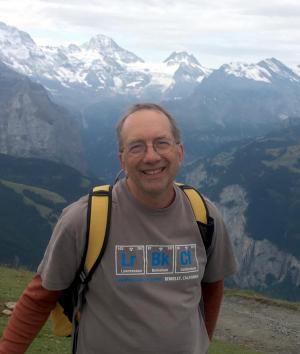 “Climate change is . . . both a moral challenge and a challenge to moral theory,” says philosophy professor William Edelglass in his feature titled “Life in the Anthropocene.” “We find ourselves caught in a situation where together we cause immense suffering and our inherited moral theory has difficulty conceptualizing any moral responsibility.”
“Climate change is . . . both a moral challenge and a challenge to moral theory,” says philosophy professor William Edelglass in his feature titled “Life in the Anthropocene.” “We find ourselves caught in a situation where together we cause immense suffering and our inherited moral theory has difficulty conceptualizing any moral responsibility.”
This new epoch of spreading deserts, shrinking ice caps, rising oceans, and growing legions of refugees poses many challenges for humans, ethically but also legislatively, scientifically, culturally, and in our practical day-to-day lives. In her feature titled “Going Through the Narrows,” MA in Teaching for Social Justice student Judy Dow shares lessons of her ancestors that call for adapting to change, something Native communities of the continent have good reason to know about.
Adapting is something Marlboro College knows about as well. In a time when small liberal arts colleges in the region are all facing significant enrollment and financial challenges, Marlboro has the optimism and agility to reimagine our curriculum and reinforce our promise to students in response to changing times. The college has also been able to leverage their longtime partnership with the Marlboro Music School and Festival for sustaining support and two new buildings.
Marlboro has long prepared students for a changing world, and the entrepreneurial activities of our alumni are a testament to this adaptability. Whether it’s arts entrepreneurs like Laura Frank ’92, Samuel Dowe-Sandes ’96, and Evan Lorenzen ’13, or justice-based bookkeeper Alex Fischer MBA ’14, alumni consistently credit Marlboro with preparing them for the entrepreneurial life. How did Marlboro prepare you for life in the Anthropocene?
How are you responding to the challenges of a changing world? If you have any insights or reactions to this issue of Potash Hill, I hope you’ll share them with me at pjohansson@marlboro.edu. —Philip Johansson, editor
Inside Front Cover
Potash Hill
Published twice every year, Potash Hill shares highlights of what Marlboro College community members, in both undergraduate and graduate programs, are doing, creating, and thinking. The publication is named after the hill in Marlboro, Vermont, where the college was founded in 1946. “Potash,” or potassium carbonate, was a locally important industry in the 18th and 19th centuries, obtained by leaching wood ash and evaporating the result in large iron pots. Students and faculty at Marlboro no longer make potash, but they are very industrious in their own way, as this publication amply demonstrates.
Alumni Director: Maia Segura ’91
Editor: Philip Johansson
Photo Editor: Richard Smith
Staff Photographers: Clayton Clemetson ’19, David Teter ’20, and Emily Weatherill ’21
Design: Falyn Arakelian
Potash Hill welcomes letters to the editor. Mail them to: Editor, Potash Hill, Marlboro College, P.O. Box A, Marlboro, VT 05344, or send email to pjohansson@marlboro.edu. The editor reserves the right to edit for length letters that appear in Potash Hill.
Front Cover: A basket woven from hand-pounded ash by Judy Dow, a teacher of traditional Abenaki culture and student in Marlboro’s MA in Teaching for Social Justice program, demonstrates traditional “cowass” designs: turns and curls representing birds, snails, and porcupine quills. “Wabanaki people have always made ash baskets,” says Judy. “However, this style is called a fancy basket, and was an adaptation during the late 1800s.” Judy shares lessons for adapting to impending environmental, social, and economic changes in her article, "Going Through the Narrows."
About Marlboro College
Marlboro College provides independent thinkers with exceptional opportunities to broaden their intellectual horizons, benefit from a small and close-knit learning community, establish a strong foundation for personal and career fulfillment, and make a positive difference in the world. At our campus in the town of Marlboro, Vermont, students engage in deep exploration of their interests— and discover new avenues for using their skills to improve their lives and benefit others—in an atmosphere that emphasizes critical and creative thinking, independence, an egalitarian spirit, and community.
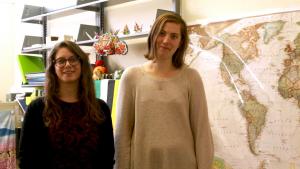 “Our job is to make sure that every international student at Marlboro has the best possible experience that they can get, and we can’t wait to welcome you here,” say Dora Musini, international services coordinator, and Emma Huse, experiential learning and global engagement coordinator. They were featured in a video produced by students as part of the national #YouAreWelcomeHere campaign, which offers welcoming messages to international students around the world. See the video.
“Our job is to make sure that every international student at Marlboro has the best possible experience that they can get, and we can’t wait to welcome you here,” say Dora Musini, international services coordinator, and Emma Huse, experiential learning and global engagement coordinator. They were featured in a video produced by students as part of the national #YouAreWelcomeHere campaign, which offers welcoming messages to international students around the world. See the video.
Up Front
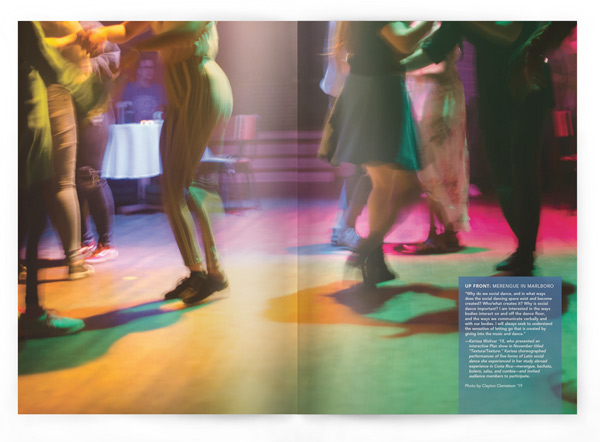
Merengue in Marlboro
“Why do we social dance, and in what ways does the social dancing space exist and become created? Who/what creates it? Why is social dance important? I am interested in the ways bodies interact on and off the dance floor, and the ways we communicate verbally and with our bodies. I will always seek to understand the sensation of letting go that is created by giving into the music and dance.”
— Karissa Wolivar ’18
Karissa presented an interactive Plan show in November titled “Textura/Texture.” Karissa choreographed performances of five forms of Latin social dance she experienced in her study abroad experience in Costa Rica—merengue, bachata, bolero, salsa, and cumbia—and invited audience members to participate.
Photo by Clayton Clemetson ’19
Clear Writing
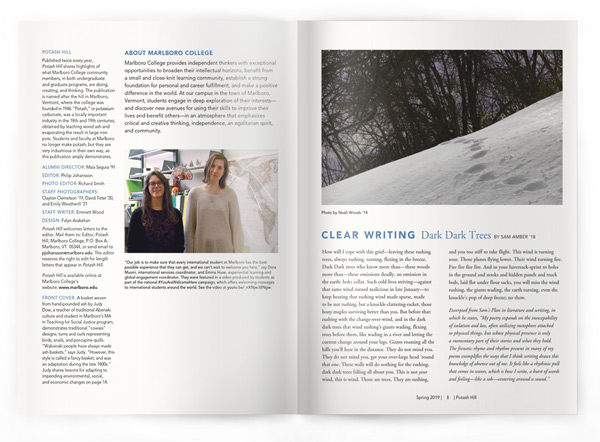
Dark Dark Trees
By Sam Amber '18
How will I cope with this grief—leaving these rushing trees, always rushing, turning, flexing in the breeze. Dark Dark trees who know more than—these woods more than—these omissions deadly, an omission in the earth: hole; cellar. Such cold lives striving—against that same wind turned malicious in late January—to keep hearing that rushing wind made sparse, made to be not rushing, but a knuckle-clattering-racket, those bony maples surviving better than you. But before that: rushing with the change-over-wind, and in the dark dark trees that wind rushing’s giants wading, flexing trees before them, like wading in a river and letting the current change around your legs. Giants roaming all the hills you’ll hear in the distance. They do not mind you. They do not mind you, get your over-large head ’round that one. These walls will do nothing for the rushing, dark dark trees falling all about you. This is not your wind, this is wind. Those are trees. They are rushing, and you too stiff to take flight. This wind is turning sour. Those planes flying lower. Their wind turning fire. Fire fire fire fire. And in your haversack-sprint to holes in the ground and nooks and hidden panels and truck beds, laid flat under flour sacks, you will miss the wind rushing, the giants wading, the earth turning, even the knuckle’s pop of deep freeze; no thaw.
Excerpted from Sam’s Plan in literature and writing, in which he states, “My poetry expands on the inescapability of isolation and loss, often utilizing metaphors attached to physical things, but whose physical presence is only a momentary part of their stories and what they hold. The frenetic rhyme and rhythm present in many of my poems exemplifies the ways that I think writing draws this knowledge of absence out of me. It feels like a rhythmic pull that comes in waves, which is how I write, a burst of words and feeling—like a sob—centering around a sound.”
Photo by Noah Woods ’14
Letters
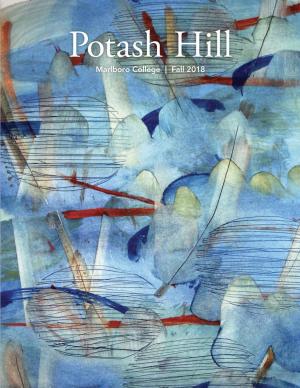 Clear Writing
Clear Writing
In “Anti-Essentialism in Black Thought” (Fall 2018), Andrew Smith Domzal ’18 identifies and clearly expresses what he is going to write about. Somewhere (Marlboro?) he has learned to write a good sentence; to write a good sentence is the beginning of thinking clearly. I like the tone and measure of his prose. I look forward to reading his Plan.
I enjoyed my two-day visit to Marlboro in the mid 1980s, when my son Stephen was a prospective student. I attended two classes, wandered the lovely, rustic campus on muddy paths, and spoke to students and staff, occasionally catching sight of Stephen, who stayed clear of me. I stayed on campus in a ramshackle building that also housed a day school for little children. I ate, with everyone, in the former barn that also served as auditorium and theater. It was a wonderful stay.
—Charles Perrone P’89
Book Shelf
Thanks for the coverage of my book All That Once Was You in Potash Hill (Fall 2018). Just got my copy. BTW, it’s really an improvement! Gorgeous magazine.
—Thomas Griffin ’86
Remembering Markus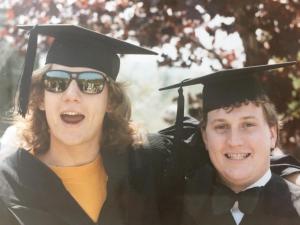 Markus Brakhan ’86 (pictured left with me), who passed away last summer (Potash Hill, Fall 2018), was a bright and vibrant part of the Marlboro community from 1982 to 1986 and wrote his Plan of Concentration on Kant and the “virtuous man.” He was a true original, whose soul deeply touched and impacted those close to him.
Markus Brakhan ’86 (pictured left with me), who passed away last summer (Potash Hill, Fall 2018), was a bright and vibrant part of the Marlboro community from 1982 to 1986 and wrote his Plan of Concentration on Kant and the “virtuous man.” He was a true original, whose soul deeply touched and impacted those close to him.
—Kip Morgan ’86
Marlboro Love
I am thankful daily for my time spent at Marlboro. I had the freedom to explore and define questions and commitments that have lasted for decades; I had a community that held me accountable, intellectually and personally. I began to learn what it means to be a thoughtful citizen. Thanks, Marlboro! Onward together.
—Mark Genszler ’95
Marlboro is a magical place. As I experienced it, every individual was honored for being the unique person they are. They were coaxed into doing their best and growing so much, so positively, throughout. This environment creates a community where you can and want to make a difference.
—Christina Crosby ’89
Policy in Action For a politics student, Marlboro is like an enormous playground, where you can test things out—Meg Mott in particular is a professor who encourages you to take what you’re learning in the classroom and test it out on her colleagues, which is funny. She was really good at encouraging us to take theories and then formulate a policy change, go to the appropriate committee, and persuade those people that it was the right policy.
For a politics student, Marlboro is like an enormous playground, where you can test things out—Meg Mott in particular is a professor who encourages you to take what you’re learning in the classroom and test it out on her colleagues, which is funny. She was really good at encouraging us to take theories and then formulate a policy change, go to the appropriate committee, and persuade those people that it was the right policy.
And I think that for me those skills were invaluable: being able to go into a room and speak to whoever was on that committee, and being able to handle that there is a time limit on what you have to say and that you have to consider what everyone thinks. There is someone in the room who vehemently disagrees with you, and you’re going to have to persuade them because you all live on campus together. That’s a really good microcosm of what my day-to-day office life is like.
— Alexia Boggs ’13, aerospace lawyer
Excerpted from the young alumni panel at Home Days 2018. See the whole panel.
Photo of Alexia and Sean Pyles ’13, also part of the alumni panel, by Kelly Fletcher
View from the Hill
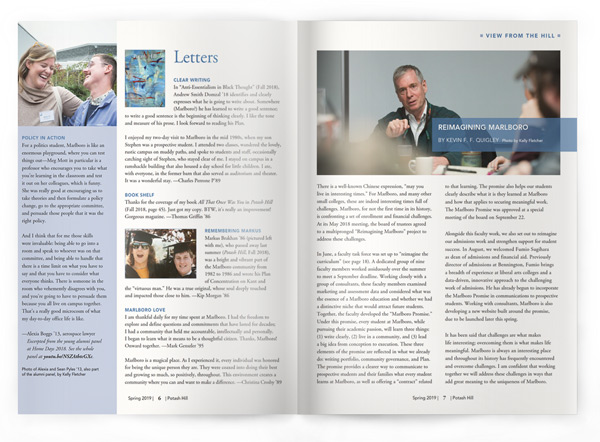
Reimagining Marlboro
By Kevin F. F. Quigley
There is a well-known Chinese expression, “may you live in interesting times.” For Marlboro, and many other small colleges, these are indeed interesting times full of challenges. Marlboro, for not the first time in its history, is confronting a set of enrollment and financial challenges. At its May 2018 meeting, the board of trustees agreed to a multipronged “Reimagining Marlboro” project to address these challenges.
In June, a faculty task force was set up to “reimagine the curriculum” (see page 18). A dedicated group of nine faculty members worked assiduously over the summer to meet a September deadline. Working closely with a group of consultants, these faculty members examined marketing and assessment data and considered what was the essence of a Marlboro education and whether we had a distinctive niche that would attract future students. Together, the faculty developed the “Marlboro Promise.” Under this promise, every student at Marlboro, while pursuing their academic passion, will learn three things: (1) write clearly, (2) live in a community, and (3) lead a big idea from conception to execution. These three elements of the promise are reflected in what we already do: writing portfolio, community governance, and Plan.
The promise provides a clearer way to communicate to prospective students and their families what every student learns at Marlboro, as well as offering a “contract” related to that learning. The promise also helps our students clearly describe what it is they learned at Marlboro and how that applies to securing meaningful work. The Marlboro Promise was approved at a special meeting of the board on September 22.
Alongside this faculty work, we also set out to reimagine our admissions work and strengthen support for student success. In August, we welcomed Fumio Sugihara as dean of admissions and financial aid. Previously director of admissions at Bennington, Fumio brings a breadth of experience at liberal arts colleges and a data-driven, innovative approach to the challenging work of admissions. He has already begun to incorporate the Marlboro Promise in communications to prospective students. Working with consultants, Marlboro is also developing a new website built around the promise, due to be launched later this spring.
It has been said that challenges are what makes life interesting; overcoming them is what makes life meaningful. Marlboro is always an interesting place and throughout its history has frequently encountered and overcome challenges. I am confident that working together we will address these challenges in ways that add great meaning to the uniqueness of Marlboro.
Photo by Kelly Fletcher
Life in the Anthropocene
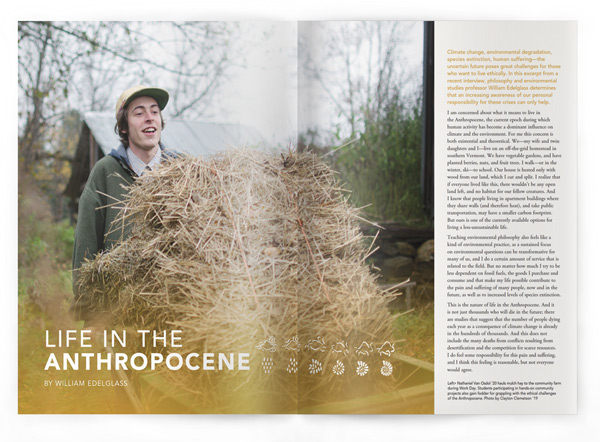
By William Edelglass
Climate change, environmental degradation, species extinction, human suffering—the uncertain future poses great challenges for those who want to live ethically. In this excerpt from a recent interview, philosophy and environmental studies professor William Edelglass determines that an increasing awareness of our personal responsibility for these crises can only help.
I am concerned about what it means to live in the Anthropocene, the current epoch during which human activity has become a dominant influence on climate and the environment. For me this concern is both existential and theoretical. We—my wife and twin daughters and I—live on an off-the-grid homestead in southern Vermont. We have vegetable gardens, and have planted berries, nuts, and fruit trees. I walk—or in the winter, ski—to school. Our house is heated only with wood from our land, which I cut and split. I realize that if everyone lived like this, there wouldn’t be any open land left, and no habitat for our fellow creatures. And I know that people living in apartment buildings where they share walls (and therefore heat), and take public transportation, may have a smaller carbon footprint. But ours is one of the currently available options for living a less-unsustainable life.
Teaching environmental philosophy also feels like a kind of environmental practice, as a sustained focus on environmental questions can be transformative for many of us, and I do a certain amount of service that is related to the field. But no matter how much I try to be less dependent on fossil fuels, the goods I purchase and consume and that make my life possible contribute to the pain and suffering of many people, now and in the future, as well as to increased levels of species extinction.
This is the nature of life in the Anthropocene. And it is not just thousands who will die in the future; there are studies that suggest that the number of people dying each year as a consequence of climate change is already in the hundreds of thousands. And this does not include the many deaths from conflicts resulting from desertification and the competition for scarce resources. I do feel some responsibility for this pain and suffering, and I think this feeling is reasonable, but not everyone would agree.
Instead of thinking about individual responsibility, one might object, we need to think about climate change as a tragedy of the commons. Instead of holding individuals responsible, then, we should work toward forging agreements that would regulate the commons that is our atmosphere. According to the tragedy of the commons view of climate change, there would be no unilateral obligation to reduce one’s own greenhouse gas emissions. Climate change and other common-pool resource problems, then, would constitute a kind of prisoners’ dilemma, in which individuals acting according to their preferences worsen the situation for everyone. What would be required, then, is an enforceable, collective agreement.
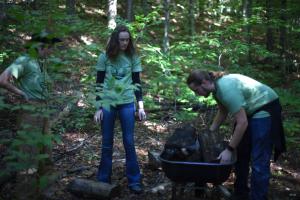 Or, one might object, while it may be the case that cumulatively our actions are catastrophic, no one individual actually causes climate change. This is sometimes called the problem of inconsequentialism: if the consequences of my actions are negligible, and there would be no discernible difference if I drove a low- or high-mileage car, then I am simply not responsible. If my individual choice of a low-mileage car doesn’t really cause climate change, then there is nothing morally wrong with it. According to this view, the only moral obligation we have is to support systemic changes at a policy level by electing and supporting politicians who will implement incentives and regulations that will make a consequential difference.
Or, one might object, while it may be the case that cumulatively our actions are catastrophic, no one individual actually causes climate change. This is sometimes called the problem of inconsequentialism: if the consequences of my actions are negligible, and there would be no discernible difference if I drove a low- or high-mileage car, then I am simply not responsible. If my individual choice of a low-mileage car doesn’t really cause climate change, then there is nothing morally wrong with it. According to this view, the only moral obligation we have is to support systemic changes at a policy level by electing and supporting politicians who will implement incentives and regulations that will make a consequential difference.
Clearly, regulation, legislation, and international political agreements are necessary to make significant progress in mitigating and adapting to climate change. Moreover, it can be problematic to hold someone morally responsible for choices that are limited by their economic and social context, in which it may be very hard to make decisions that result in fewer greenhouse gas emissions.
There are also theoretical obstacles to understanding individual moral responsibility in the context of climate change. As Dale Jamieson, a philosopher at NYU, has argued, climate change and other collective-action environmental problems pose a challenge to our traditional conceptions of moral responsibility. Because individually my actions are inconsequential, I intend no harm, and there is no immediate victim, according to the standard account of responsibility I am not responsible for the suffering that results from climate change.
Climate change is thus both a moral challenge and a challenge to moral theory because we find ourselves caught in a situation where together we cause immense suffering and our inherited moral theory has difficulty conceptualizing any moral responsibility. But there are vast numbers of people today who do feel morally responsible. And I think there are ways of conceptualizing moral responsibility that make sense of that feeling. One way is by drawing on the work of Emmanuel Levinas (1906–95), the Lithuanian-French phenomenologist whose account of responsibility turns the standard approach on its head.
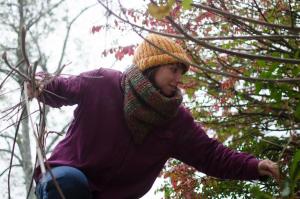 In Levinas’s moral phenomenology, responsibility is not grounded in intention and causality. According to most moral philosophies, and our common intuitions, we are responsible for acts that we choose, especially when we understand the consequences of our choices. Likewise, causal responsibility is generally understood to be a necessary, though not sufficient, condition for moral responsibility.
In Levinas’s moral phenomenology, responsibility is not grounded in intention and causality. According to most moral philosophies, and our common intuitions, we are responsible for acts that we choose, especially when we understand the consequences of our choices. Likewise, causal responsibility is generally understood to be a necessary, though not sufficient, condition for moral responsibility.
Thus, we generally tend to recognize moral responsibility for acts that are close in space and time, where we see clear connections between perpetrators and victims. In the standard account, because ought implies can, responsibility does not demand more than is reasonably possible for the agent. However, for Levinas, ethical consciousness is precisely the sense of responsibility for the Other, even when I myself have done nothing to harm her. And the more attentive I am the more I recognize my own responsibility.
In a brief autobiographical sketch titled “Signature,” Levinas writes that his life and work were “dominated by the presentiment and the memory of the Nazi horror.” Levinas himself entered the French military and was captured shortly after the start of the Second World War. He spent the next four years in a labor camp in Germany, hearing rumors of the murder of European Jews. His parents, grandparents, both his brothers, and many others close to him were killed by the Nazis; Levinas’s wife and daughter spent the war years hiding in France. For Levinas, the Nazi horror and the goodness of some when confronted by overwhelming force, demanded a radical rethinking of ethics, which became the central philosophical project of his life. It is primarily a project of rethinking our relationship to the other person, which, as he notes, also demands a rethinking of subjectivity.
In contrast to most Western moral philosophies, Levinas’s ethics offers no universal moral principles or prescriptions. He does not seek to answer the questions that animate these traditions, such as: “what is the best human life?”; “how should I live?”; “how ought one to act?”; or “what principles of moral reason can determine what one ought to do?” Instead, Levinas describes the very moral consciousness that precedes and motivates all moral thinking and action. In part due to this approach, then, Levinas’s thought is not in tension with virtue ethics, deontology, consequentialism, or other moral theories; it is operating at a prior level.
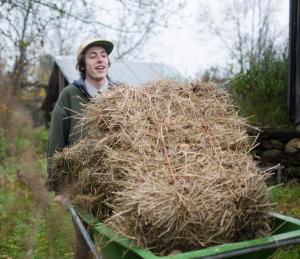 Levinas’s phenomenology describes a normative force to respond to the Other, to engage in the world, but there is no particular rule to follow or virtue to cultivate that would be universally applicable. For Levinas, then, there is no escape from the moral dilemmas of social life, for we are incessantly called by a responsibility to address needs that always demand more than the capacities and resources we possess. This will sound familiar to anyone who considers the global crisis of climate change their moral responsibility.
Levinas’s phenomenology describes a normative force to respond to the Other, to engage in the world, but there is no particular rule to follow or virtue to cultivate that would be universally applicable. For Levinas, then, there is no escape from the moral dilemmas of social life, for we are incessantly called by a responsibility to address needs that always demand more than the capacities and resources we possess. This will sound familiar to anyone who considers the global crisis of climate change their moral responsibility.
Levinas’s ethics of difference and singularity has been quite influential, provoking increased attention to ethical aspects of social life in a variety of fields in the humanities and social sciences. His work is not, however, generally regarded as an intellectual resource for thinking about environmental issues. But I believe Levinas does have something to offer us in this new era of global crises.
A generation ago, many environmental philosophers and activists tended to ground their work in one form or another of non-anthropocentrism. These views recognized an intrinsic value in nature that made it important to consider nature as a subject of our ethics. The idea that “nature,” as some abstract, ahistorical other to humans and human culture, could be a source of moral obligation is alien to Levinas’s thought. For Levinas, “nature” is precisely that realm which is outside the purview of ethics; it is distinguished instead by its drive to persist and its inability to put the Other before the self as humans are able.
Today, though, many environmental thinkers and activists articulate their concerns using conceptual frameworks that are less reliant on non-anthropocentric metaphysical and ethical views. Indeed, the climate movement, including the intellectual work that motivates it, is now very much a climate justice movement. Levinas’s recurrent concern with “the precariousness of the Other” resonates with this contemporary emphasis on climate justice, with a concern for the ways in which resource depletion and pollution overload harm humans as well as other animals.
The ethical challenges of the Anthropocene call for new approaches and fresh looks at old ones. Levinas’s account of responsibility works well for understanding our moral situation in collective-action environmental challenges such as climate change. More generally, I find Levinas’s phenomenology provides an apt description of ethical life in the Anthropocene: I have inescapable responsibilities that increase with my awareness and are always beyond my capacities to meet. That will not keep me from trying, and learning, and teaching my way into this new epoch.
William Edelglass is professor of philosophy and environmental studies, and co-editor of Facing Nature: Levinas and Environmental Thought (Duquesne University Press, 2012). He co-edits the journal Environmental Philosophy and has served as co-director of the International Association of Environmental Philosophy (IAEP), where he is currently chair of the board of directors. This article is excerpted and adapted from an interview William did on 3:AM.
Unintended Consequences of Growth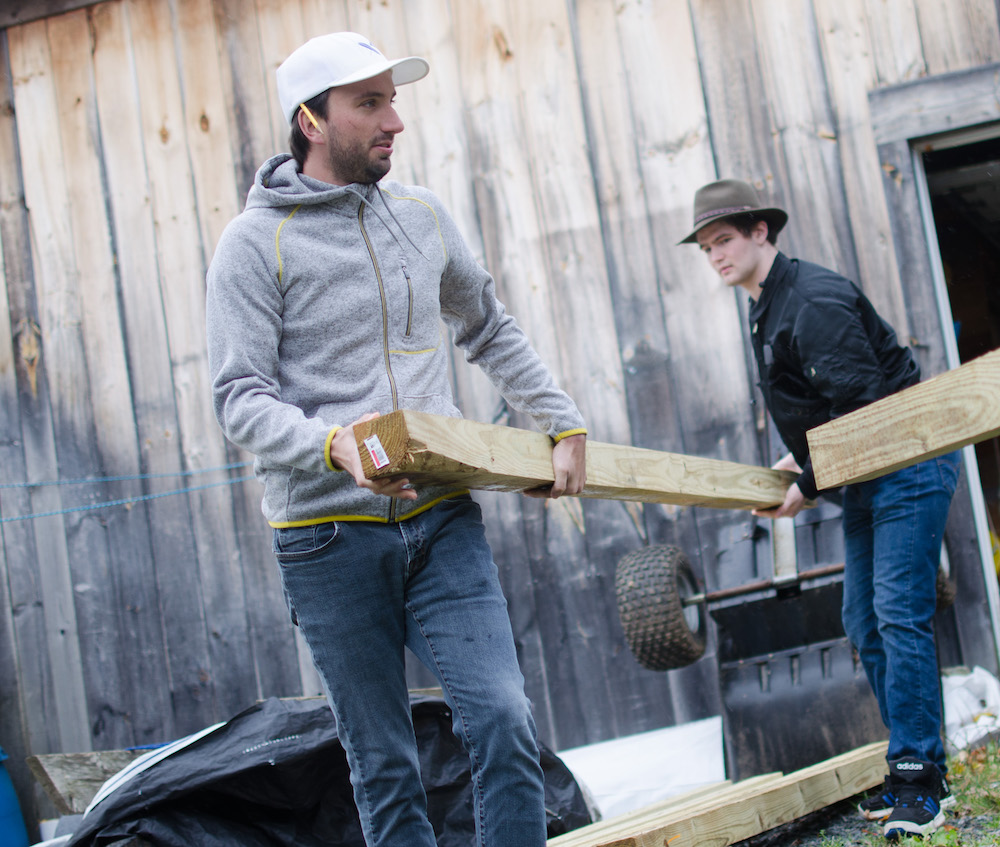 “I found it unbelievable that we rely so heavily on a number presumed to be infinite, Gross Domestic Product (GDP), while we count the extraction of finite resources in its measurement of growth,” says Spencer Knickerbocker ’19, who is completing his Plan in economics. “I also struggled with the fact that the number in no way captures the cost of environmental degradation.” Spencer’s Plan explores the history of GDP, with an emphasis on how using this instrument pushes policy with unintended consequences. He also investigates two alternative instruments to measure societal well-being, and creates his own index that measures elements of economic performance, environmental degradation, and inequality. “I have a growing interest in, and concern for, our future with regards to climate change and resource extraction. It is time for new standards.”
“I found it unbelievable that we rely so heavily on a number presumed to be infinite, Gross Domestic Product (GDP), while we count the extraction of finite resources in its measurement of growth,” says Spencer Knickerbocker ’19, who is completing his Plan in economics. “I also struggled with the fact that the number in no way captures the cost of environmental degradation.” Spencer’s Plan explores the history of GDP, with an emphasis on how using this instrument pushes policy with unintended consequences. He also investigates two alternative instruments to measure societal well-being, and creates his own index that measures elements of economic performance, environmental degradation, and inequality. “I have a growing interest in, and concern for, our future with regards to climate change and resource extraction. It is time for new standards.”
Going Through the Narrows
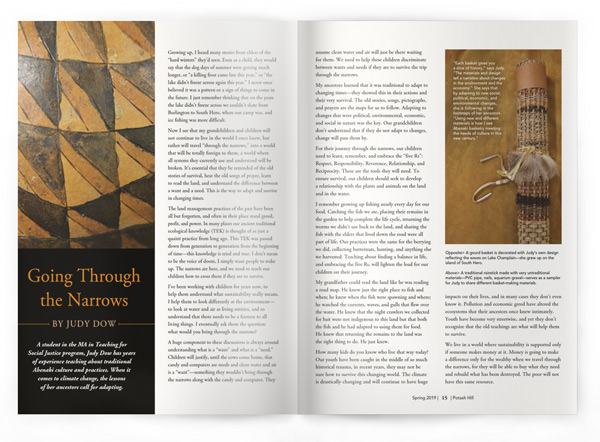
By Judy Dow
A student in the MA in Teaching for Social Justice program, Judy Dow has years of experience teaching about traditional Abenaki culture and practices. When it comes to climate change, the lessons of her ancestors call for adapting.
Growing up, I heard many stories from elders of the “hard winters” they’d seen. Even as a child, they would say that the dog days of summer were getting much longer, or “a killing frost came late this year,” or “the lake didn’t freeze across again this year.” I never once believed it was a pattern or a sign of things to come in the future. I just remember thinking that on the years the lake didn’t freeze across we couldn’t skate from Burlington to South Hero, where our camp was, and ice fishing was more difficult.
Now I see that my grandchildren and children will not continue to live in the world I once knew, but rather will travel “through the narrows,” into a world that will be totally foreign to them, a world where all systems they currently use and understand will be broken. It’s essential that they be reminded of the old stories of survival, hear the old songs of prayer, learn to read the land, and understand the difference between a want and a need. This is the way to adapt and survive in changing times.
The land management practices of the past have been all but forgotten, and often in their place stand greed, profit, and power. In many places our ancient traditional ecological knowledge (TEK) is thought of as just a quaint practice from long ago. This TEK was passed down from generation to generation from the beginning of time—this knowledge is tried and true. I don’t mean to be the voice of doom, I simply want people to wake up. The narrows are here, and we need to teach our children how to cross them if they are to survive.
I’ve been working with children for years now, to help them understand what sustainability really means. I help them to look differently at the environment— to look at water and air as living entities, and to understand that there needs to be a fairness to all living things. I eventually ask them the question: what would you bring through the narrows?
A huge component to these discussions is always around understanding what is a “want” and what is a “need.” Children will justify, until the cows come home, that candy and computers are needs and clean water and air is a “want”—something they wouldn’t bring through the narrows along with the candy and computer. They assume clean water and air will just be there waiting for them. We need to help these children discriminate between wants and needs if they are to survive the trip through the narrows.
My ancestors learned that it was traditional to adapt to changing times—they showed this in their actions and their very survival. The old stories, songs, pictographs, and prayers are the maps for us to follow. Adapting to changes that were political, environmental, economic, and social in nature was the key. Our grandchildren don’t understand that if they do not adapt to changes, change will pass them by.
For their journey through the narrows, our children need to learn, remember, and embrace the “five Rs”: Respect, Responsibility, Reverence, Relationship, and Reciprocity. These are the tools they will need. To ensure survival, our children should seek to develop a relationship with the plants and animals on the land and in the water.
I remember growing up fishing nearly every day for our food. Catching the fish we ate, placing their remains in the garden to help complete the life cycle, returning the worms we didn’t use back to the land, and sharing the fish with the elders that lived down the road were all part of life. Our practices were the same for the berrying we did, collecting butternuts, hunting, and anything else we harvested. Teaching about finding a balance in life, and embracing the five Rs, will lighten the load for our children on their journey.
My grandfather could read the land like he was reading a road map. He knew just the right place to fish and when; he knew when the fish were spawning and where; he watched the currents, waves, and gulls that flew over the water. He knew that the night crawlers we collected for bait were not indigenous to this land but that both the fish and he had adapted to using them for food. He knew that returning the remains to the land was the right thing to do. He just knew.
How many kids do you know who live that way today? Our youth have been caught in the middle of so much historical trauma, in recent years, they may not be sure how to survive this changing world. The climate is drastically changing and will continue to have huge impacts on their lives, and in many cases they don’t even know it. Pollution and economic greed have altered the ecosystems that their ancestors once knew intimately. Youth have become very streetwise, and yet they don’t recognize that the old teachings are what will help them to survive.
We live in a world where sustainability is supported only if someone makes money at it. Money is going to make a difference only for the wealthy when we travel through the narrows, for they will be able to buy what they need and rebuild what has been destroyed. The poor will not have this same resource.
Catastrophic storms are beating our shores, washing away the world we know. Towns are being deemed unlivable, sometimes for months and years, and some are being lost forever. Sustainability is understanding that we are responsible for our actions and then doing something about it; all the money in the world won’t fix the environmental problems we have today. It’s time to wake up for our children—allowing them to grow up is our responsibility and the right thing to do.
Loss of life and property is only half the story. We are looking at a rate of evolution in our natural world that we’ve not seen in our lifetimes. Polar bears and grizzly bears are mating; so are different species of everything from butterflies to sharks. The scientific community has recognized this genetic mixing in owls, squirrels, big cats, and wild canines. Is this hybridization natural? Some species-extinction experts say that wiping out hybrids is the best way to protect a threatened species. The lawmakers and wildlife managers will decide what will happen to these hybrid beings, while the people that depend on the land for survival will be dismissed as quaint Indian people who can’t keep up with the times.
The Abenaki have no word for time: when everyone is together and everything is ready, and only then, is it “time.” We understand that we live in a world with limited amounts of birds, fish, animals, and plants, and we’ve grown up understanding the sun rises every morning and sets every night at a predicted time. We’ve learned to read the seasons and the land, and to live with these and the many other predictable natural events we experience day to day.
Many of us have become at peace with the world we live in, assuming this is the way it will always be. Many of us have grown up never getting intimately involved in the world around us unless we are directly affected. While we’ve ignored the bigger picture, our world has changed; we are beginning the passage from the world we now know, through the narrows and into a new world. A different world than we could ever imagine. Life will be difficult, at best, for some, and unbearable for others— and costly in many ways for everyone. The “time” is right to embrace the five Rs and accept adaptation before it is too late.
Judy is a nationally known activist, basket maker, and teacher of traditional Abenaki culture and practices. She is the author of “Understanding the Vermont Eugenics Survey and Its Impacts Today,” in Global Indigenous Health, edited by Robert Henry et al., University of Arizona Press (2018), as well as many other essays. The MA in Teaching for Social Justice program is a collaboration between Marlboro College and Spark Teacher Education Institute: marlboro.edu/spark.
Finding Cultural Connection to the Land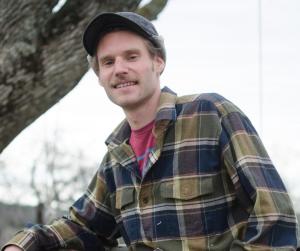 “The struggle to protect landscapes from exploitation is simultaneously an effort to preserve the cultures whose understanding of the world is deeply imbedded within those landscapes,” says Chris Lamb ’18. As part of his Plan in philosophy, environmental studies, and literature, Chris had a life-changing internship experience with the Black Mesa Water Coalition, a Diné environmental justice group based in Flagstaff, Arizona. He drew upon this experience to demonstrate the ceremonial and spiritual implications of food sovereignty—and by extension Indigenous activism— as demonstrated by the restoration of traditional corn fields. “Though places and landscapes play a fundamental role in the fabric of all cultures, Diné people have chosen to actively participate in the interplay between human and nonhuman forces in a way that illuminates the power of place and gives agency to the more-than-human world.”
“The struggle to protect landscapes from exploitation is simultaneously an effort to preserve the cultures whose understanding of the world is deeply imbedded within those landscapes,” says Chris Lamb ’18. As part of his Plan in philosophy, environmental studies, and literature, Chris had a life-changing internship experience with the Black Mesa Water Coalition, a Diné environmental justice group based in Flagstaff, Arizona. He drew upon this experience to demonstrate the ceremonial and spiritual implications of food sovereignty—and by extension Indigenous activism— as demonstrated by the restoration of traditional corn fields. “Though places and landscapes play a fundamental role in the fabric of all cultures, Diné people have chosen to actively participate in the interplay between human and nonhuman forces in a way that illuminates the power of place and gives agency to the more-than-human world.”
The Cost of Cheaper Milk
By Don Dennis '82
 I’m pretty sure I am the only American milkman in Scotland, the result of my having married a dairy farmer over here on one of the smaller islands. Due to the collapse of the bulk milk price, we began pasteurising and bottling Emma’s milk in returnable glass bottles two years ago, selling it through small village shops in this sparsely populated county. Along the way, we discovered that good-tasting milk has been almost entirely removed from the marketplace in most developed countries.
I’m pretty sure I am the only American milkman in Scotland, the result of my having married a dairy farmer over here on one of the smaller islands. Due to the collapse of the bulk milk price, we began pasteurising and bottling Emma’s milk in returnable glass bottles two years ago, selling it through small village shops in this sparsely populated county. Along the way, we discovered that good-tasting milk has been almost entirely removed from the marketplace in most developed countries.
It was the arrival of the supermarkets, and the accompanying decline in home deliveries of milk, that brought this about. Fifty years ago, milk tasted better because it was pasteurized at a low temperature (63˚C) and held there for 30 minutes. The supermarkets came along and wanted cheaper milk to lure in the customers. And so the dairy processing companies introduced pasteurizing at 73˚C for 15 seconds, which is at least 120 times faster as a process, hence far cheaper. The fact that it drastically harms the taste was not the supermarkets’ concern. They got the cheap milk they wanted.
Something akin to that has happened with organic milk in the US: 80 percent of it is Ultra-High Temperature (UHT) treated (heated to more than 135˚C), so as to give it a six-month shelf life. The supermarkets wouldn’t carry it unless it had that sort of shelf life, as it is too much of a niche item.
In Australia, most milk is pasteurised at 81.6˚C for only two seconds! You can see the trend. Milk is supposed to be as cheap as possible, and so you reduce the costs of farming by having mega-herds of cows that stay indoors 365 days a year and never see grass; and you speed up the pasteurizing process, no matter what the cost is in terms of taste.
Ours is the only commercial dairy in Scotland that pasteurizes milk the old-fashioned way, with the low-temperature protocol. Hence it costs considerably more than supermarket white stuff. And yet we have found that it sells well anywhere we can reach with our distribution. People are continually amazed, and grateful, to find milk that tastes like the milk they had when they were children 50 or more years ago. And the glass bottle is a bonus.
Don Dennis delivers his Wee Isle Dairy whole milk from the isle of Gigha to points in Scotland as far away as Edinburgh, Penicuik, and Peebles. As if that’s not enough, he is also director of the Flower Essence Repertoire Ltd, producing a unique range of flower essences with tropical orchids. Learn more at healingorchids.com. Photos by Don Dennis
On and Off the Hill
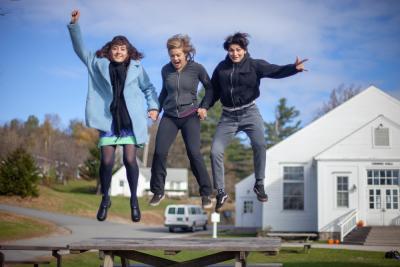 New focus on curriculum, new faculty, new library grants, and new connections between old friends at Home Days 2018. It all happens right here at Marlboro and you can read about it in On and Off the Hill.
New focus on curriculum, new faculty, new library grants, and new connections between old friends at Home Days 2018. It all happens right here at Marlboro and you can read about it in On and Off the Hill.
Faculty Reimagine Curriculum
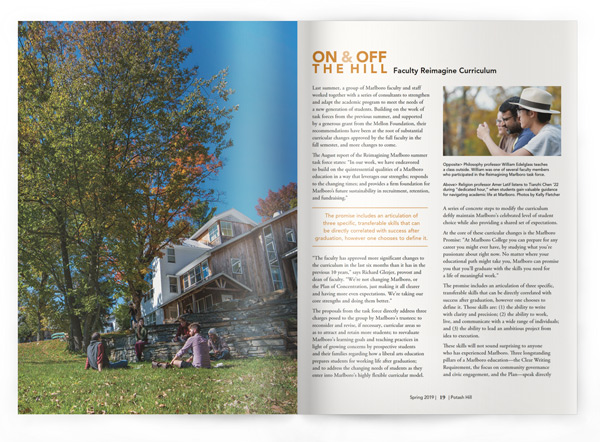
Last summer, a group of Marlboro faculty and staff worked together with a series of consultants to strengthen and adapt the academic program to meet the needs of a new generation of students. Building on the work of task forces from the previous summer, and supported by a generous grant from the Mellon Foundation, their recommendations have been at the root of substantial curricular changes approved by the full faculty in the fall semester, and more changes to come.
The August report of the Reimagining Marlboro summer task force states: “In our work, we have endeavored to build on the quintessential qualities of a Marlboro education in a way that leverages our strengths; responds to the changing times; and provides a firm foundation for Marlboro’s future sustainability in recruitment, retention, and fundraising.”
“The faculty has approved more significant changes to the curriculum in the last six months than it has in the previous 10 years,” says Richard Glezjer, provost and dean of faculty. “We’re not changing Marlboro, or the Plan of Concentration, just making it all clearer and having more even expectations. We’re taking our core strengths and doing them better.”
The proposals from the task force directly address three charges posed to the group by Marlboro’s trustees: to reconsider and revise, if necessary, curricular areas so as to attract and retain more students; to reevaluate Marlboro’s learning goals and teaching practices in light of growing concerns by prospective students and their families regarding how a liberal arts education prepares students for working life after graduation; and to address the changing needs of students as they enter into Marlboro’s highly flexible curricular model. A series of concrete steps to modify the curriculum deftly maintain Marlboro’s celebrated level of student choice while also providing a shared set of expectations.
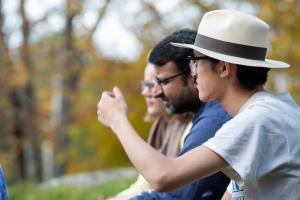 At the core of these curricular changes is the Marlboro Promise: “At Marlboro College you can prepare for any career you might ever have, by studying what you’re passionate about right now. No matter where your educational path might take you, Marlboro can promise you that you’ll graduate with the skills you need for a life of meaningful work.”
At the core of these curricular changes is the Marlboro Promise: “At Marlboro College you can prepare for any career you might ever have, by studying what you’re passionate about right now. No matter where your educational path might take you, Marlboro can promise you that you’ll graduate with the skills you need for a life of meaningful work.”
The promise includes an articulation of three specific, transferable skills that can be directly correlated with success after graduation, however one chooses to define it. Those skills are: (1) the ability to write with clarity and precision; (2) the ability to work, live, and communicate with a wide range of individuals; and (3) the ability to lead an ambitious project from idea to execution.
These skills will not sound surprising to anyone who has experienced Marlboro. Three longstanding pillars of a Marlboro education—the Clear Writing Requirement, the focus on community governance and civic engagement, and the Plan—speak directly to each of them, respectively. What is new here is a focus on reaching all students with these transformative experiences, and a renewed emphasis on bolstering, documenting, and articulating the skills they support.
“Last summer’s reimagining work created the Marlboro Promise, which is a set of shared curricular goals,” says Kristin Horrigan, professor of dance and gender studies and one of the nine faculty members on the task force. “The faculty’s job for this year is to design and implement the changes that will make the Marlboro Promise a reality for all students. These changes take place in our own classrooms, as well as in the structures that support and guide a student’s four years at Marlboro.”
“The three goals provide us with a much more precise map of the Marlboro territory,” says Meg Mott, professor of politics and another member of the task force. “While we’ve always cohabitated in the land of clear writing, now we dwell in a terrain that includes two other commitments: project management and working with a wide range of individuals.”
Kristin suggests that goal number two, a commitment to teaching all students the skills they need to “live, work, and communicate with a wide range of individuals,” represents the most significant shift in the curriculum. But structural changes that support that commitment are still being drafted by faculty committees and will be debated in the spring, so in a sense the most significant changes are still to come.
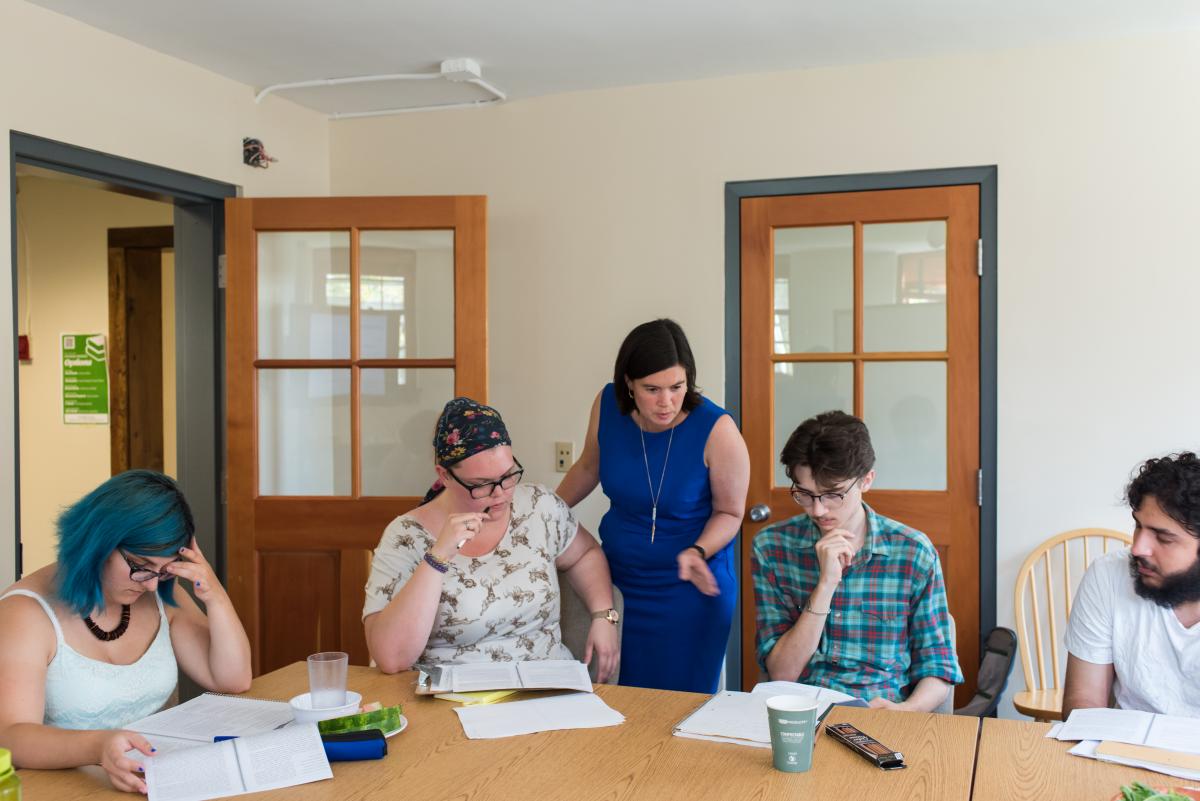 “While students at Marlboro have always had the opportunity to gain these skills by participating in community governance and engaging in community life on a small campus, no one was required to participate,” says Kristin. “Let me be clear that the promise does not mean we are now requiring unwilling students to participate in community governance. Rather we will be providing a range of pathways to allow students to foster these skills, and setting one or more checkpoints where students will need to demonstrate their learning.”
“While students at Marlboro have always had the opportunity to gain these skills by participating in community governance and engaging in community life on a small campus, no one was required to participate,” says Kristin. “Let me be clear that the promise does not mean we are now requiring unwilling students to participate in community governance. Rather we will be providing a range of pathways to allow students to foster these skills, and setting one or more checkpoints where students will need to demonstrate their learning.”
Recent additions to the curriculum that will help support and document the goals of the Marlboro Promise include a new first-year seminar, taken by all first-year students, that provides a clear on-ramp to Marlboro’s unique curricular structure. The seminar serves as an introduction to the four-year “progression,” and clearly articulates the skills students will gain at Marlboro.
Other changes are under consideration by faculty this spring, such as an opportunity for reflection and assessment near the end of each student’s four years, before the completion of their Plan of Concentration. A component of their Plan due during their junior 2 or senior 1 semester would help to support more even progress toward completion and also provide valuable finished work in time for graduate school applications.
“Students who wanted to continue on to graduate school were finding they did not have completed components of their Plan in time to submit them with their applications, so they weren’t applying until the following year,” says Richard. “This early component of the Plan would serve that purpose and also provide a point for reflection on the Plan direction and scope.” More proposed changes to the curriculum would assess students’ process toward the three stated goals at every stage of their progression.
“To me, the most significant shift lies in analyzing the Marlboro curriculum across the full four years with an eye to how we can support students at each point along the way,” says Bronwen Tate, professor of writing and literature and task force member. “This means asking questions like, ‘If we’re thinking of the Plan process as one in which students learn to manage a complex project, are we actually providing our students with explicit opportunities to learn these skills or just hoping that they pick them up along the way?’”
Bronwen continues: “As I tell my writing students, some writing difficulties are necessary and useful, while others—writing in isolation, say, or at the last possible minute—are pointless and avoidable. The reimagining work asks how we can reduce unnecessary confusions and pitfalls so that students have the motivation and joy to face the necessary difficulties of learning and growth. As a writing professor, specifically, I’m excited by the college’s reaffirmed commitment to writing and by the willingness of colleagues across the curriculum to learn together how to be better writing teachers.”
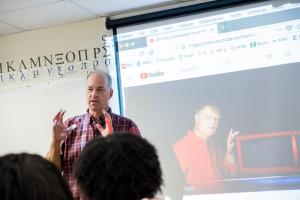 Where the rubber hits the road, so to speak, is of course in the classroom. For many teachers, the Marlboro Promise will mean a substantial shift in how they teach, document, and assess their students, while others consider the changes less dramatic.
Where the rubber hits the road, so to speak, is of course in the classroom. For many teachers, the Marlboro Promise will mean a substantial shift in how they teach, document, and assess their students, while others consider the changes less dramatic.
“Each of our classes will have to help develop students’ abilities in one or more of these areas—so I have to decide which courses will emphasize which skills,” says Todd Smith, chemistry professor. “I think the biggest change will involve reviewing each of our individual curricula to ensure that it has the structure to support the skill development, while also providing specific content.”
“Instead of using finished essays as the sole means of evaluating mastery of course content, I now offer the option of generating a final presentation for the community that sets out the controversies of the topic through a well-coordinated panel of confident speakers,” says Meg. “The panel operates as a group essay, one that could easily turn into a google doc. Even though writing did not occur, the skills needed to produce a strong piece of writing are given sufficient time.”
“Will it change the way I teach? Not really,” says Adam Franklin-Lyons, professor of history and environmental studies and a member of the task force. Adam expressed some concern that the reimagining made Marlboro look more like other schools, “although Marlboro is and will always remain a unique institution and community.’”
Amer Latif, professor of religion and task force member, says, “The Marlboro Promise allows me to frame the usual duality of instrumentality (transferable skills, making a living, jobs, etc.) and ‘learning as its own end’ in a non-dual manner. I’m very happy with this formulation. I have introduced the promise in all of my classes and am using the framework for situating the activities we do in class. For example, I have institutionalized a formal ‘setting of intention’ at the beginning of each class where students take turns to lead us in creating a space for meaningful conversation. I speak of this activity as training in leadership and reiterate the values and skills associated with the small things we do in class.”
“I think the most significant ‘change’ to the curriculum is not necessarily a change but rather an intentional commitment to the values that the college has always held dear—engaged citizenship, clear communication, and Plan,” says Jaime Tanner, biology professor. “In particular, the articulation of our value for engaged citizenship as part of our curriculum challenges each of us as faculty to evaluate not just what we are teaching but how we ask our students to engage with one another through our courses, how to foster collaboration and encourage dialogue even in the face of disagreement.”
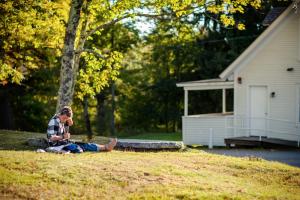 Although it was not originally part of the Reimagining Marlboro process, another important change to the curriculum this year was the adoption of “fields of concentration” to replace the “degree fields” that are attached to Plans. While degree fields were associated with specific learning goals devised by the faculty, the fields of concentration will have goals defined by students specific to their area of research. They will include the degree fields you may be familiar with but can include additional fields subject to approval by faculty.
Although it was not originally part of the Reimagining Marlboro process, another important change to the curriculum this year was the adoption of “fields of concentration” to replace the “degree fields” that are attached to Plans. While degree fields were associated with specific learning goals devised by the faculty, the fields of concentration will have goals defined by students specific to their area of research. They will include the degree fields you may be familiar with but can include additional fields subject to approval by faculty.
“The introduction of fields of concentration has been a long time coming, and is more in keeping with Marlboro’s student-driven pedagogy than the rigid degree fields,” says Richard. “The fact that it has been approved in the same breath, almost, as the Marlboro Promise reinforces and confirms the move. In the end, the specific field you choose is not as important as the process and the skills acquired along the way.”
The Reimagining Marlboro effort addresses the longstanding concern that while the Marlboro experience is extraordinary, the college is not delivering that experience evenly to every student. For Marlboro to succeed and thrive, it must be able to make that promise to every Marlboro student—not just those students who become our success stories, buying into our model and stepping up to the challenge of their own initiative. Although still a work in progress, the ongoing reimagining will establish the milestones or “hand-holds” (in the rock-climbing sense, not the crossing-the-street sense) to make that promise a reality, with enormous implications for student recruitment, retention, graduation rates, and alumni engagement.
Creating Space for Critical Conversations
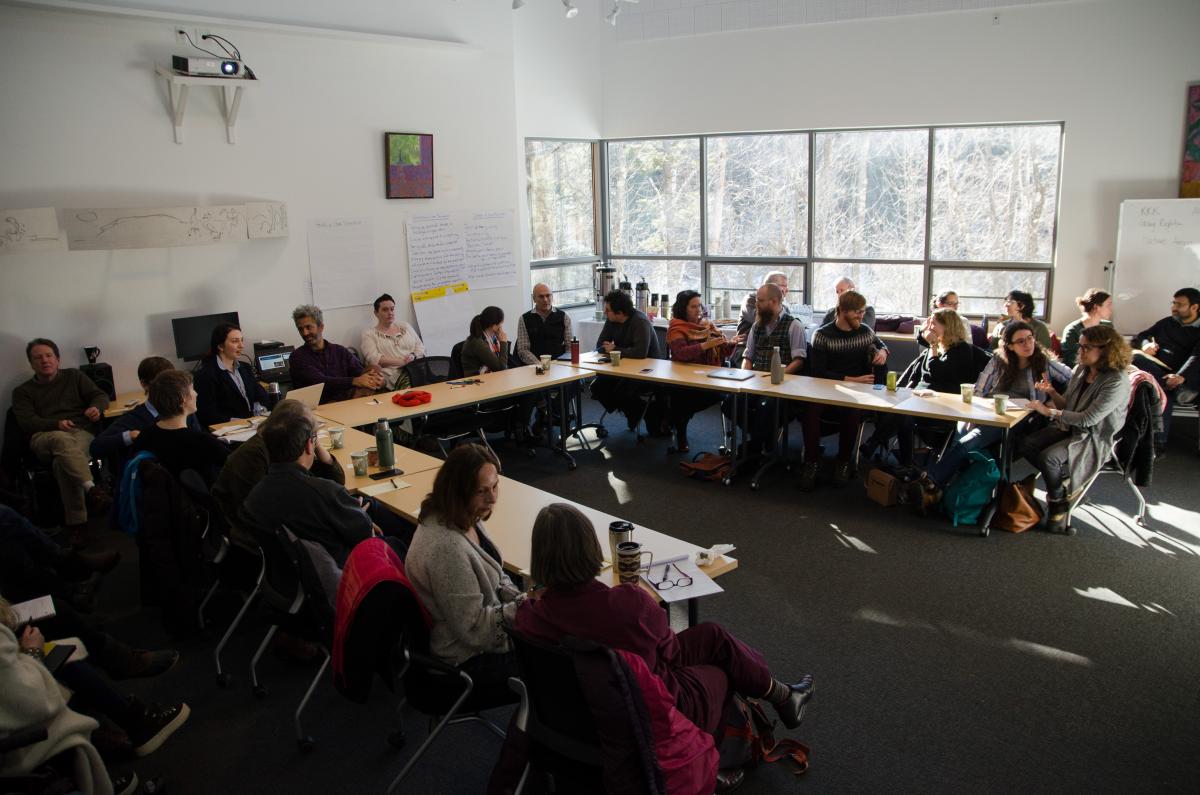 In December, faculty members participated in a workshop in civil discourse designed to support their commitment to the second goal of the Marlboro Promise: the ability to work, live, and communicate with a wide range of individuals. Sponsored by the Diversity and Inclusion Task Force, the faculty development workshop was titled “Creating Space for Critical Conversations” and was facilitated by Renee Wells, director of education for equity and inclusion at Middlebury College. The workshop was supported by a grant from the Mellon Foundation.
In December, faculty members participated in a workshop in civil discourse designed to support their commitment to the second goal of the Marlboro Promise: the ability to work, live, and communicate with a wide range of individuals. Sponsored by the Diversity and Inclusion Task Force, the faculty development workshop was titled “Creating Space for Critical Conversations” and was facilitated by Renee Wells, director of education for equity and inclusion at Middlebury College. The workshop was supported by a grant from the Mellon Foundation.
“Having Renee Wells on campus was a valuable opportunity for us to work toward fulfilling our commitment to the Marlboro Promise and for us to engage difficult pedagogical opportunities appropriately,” said William Ransom, sculpture professor and member of the Diversity and Inclusion Task Force. “The workshop offered strategies to create more inclusive classroom spaces.”
The training explored the challenges associated with class discussion, and helped faculty develop skills to set the tone for critical conversations and to intervene and respond when comments or questions result in harm. Key concepts addressed included establishing expectations and intended outcomes for dialogue, and helping students to analyze not only their own ideas and the ideas of others but the impact of those ideas on others. Faculty left with a better sense of how to frame these issues for students, help students critically self-reflect, and respond to microaggressions when they occur.
Ian McManus Asks Big Political Questions
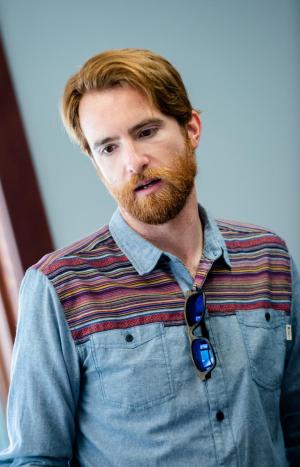 “I’m really interested in having students understand the complex world in which we live,” says Ian McManus, who joined Marlboro this fall to teach comparative politics and political economy. “We live in societies where economic influences, political institutions, social norms, and culture shape the world around us. So I’m interested in helping students develop the skills to critically analyze that world.”
“I’m really interested in having students understand the complex world in which we live,” says Ian McManus, who joined Marlboro this fall to teach comparative politics and political economy. “We live in societies where economic influences, political institutions, social norms, and culture shape the world around us. So I’m interested in helping students develop the skills to critically analyze that world.”
Ian came to Marlboro from a fellowship in social policy at the London School of Economics and Political Science and a postdoctoral research fellowship at the University of Lisbon. He has a PhD from Northeastern University, where his doctoral dissertation explored the effects of the global financial crisis across welfare states. He teaches courses that offer cross-national perspectives on pressing political, economic, and social concerns, from gender equality to political polarization, subjects that he is passionate about.
For example, in the fall he taught a course on the Politics of Global Inequality. “Students looked at global inequality from a historical context, then saw how it is now, then asked big questions,” Ian says. “Why is it like that? What’s driving inequality? What are the causes and consequences of inequality? And then, ultimately, what are some things we could do to address this issue? So the course is about asking big questions, and trying to have a meaningful impact in the world too.” He also taught a course on populist politics around the world called Rage Against the Machine: Populist Politics in the Age of Trump and Brexit.
Ian enjoys inspiring students to become engaged learners and active participants in our complex political world. He encourages them to bring their own experiences and interests to the classroom, and by doing so contribute to each other’s learning experience. He feels that this creates an environment where the class can explore even the knottiest of questions.
“Ideally you come to class with your own interests and passions, and as you learn more about the world, about policies and outcomes, you can start to think about ‘How can I apply what I’ve learned to issues that I’m passionate about in order to shape the world in important ways?’ I’m trying to get students involved. For instance, I know that there are local community projects that deal with issues like poverty and inequality, so after thinking about global inequality you could also look at inequality in your own community.”
As a politics professor, Ian has a special interest in shared governance at Marlboro and looks forward to being more involved in committees and Town Meeting. His own classes stand to benefit greatly from the college’s emphasis on student engagement in the campus community.
“It’s one thing to be here in person, physically on campus, and another to be engaged in the processes of the college,” Ian says. He is impressed by the diversity of opinion he finds in the classroom, as well as at Town Meeting, in a rural area that one might assume was homogenous. “This idea of direct democracy—being able to have a say in decisions that affect students, faculty, staff, and the whole community— is an exciting one and there is a real focus on this principle at Marlboro, which is really nice. Given Marlboro’s size we are able to engage in democracy and community decision-making in meaningful ways that larger schools couldn’t.”
Meanwhile, Ian is also working on a book based on his dissertation as well as several further articles on the politics of social and economic policymaking across countries. “This work addresses issues like the distributional effects of the Great Recession, the effects of international institutions on domestic policies, the influence of political parties and ideologies on social spending, and the negative effects of inequality on economic growth and social well-being.”
As fate would have it, Ian actually grew up just a stone’s throw away, in Chesterfield, New Hampshire, so has known about Marlboro—“this intentionally small learning community”—for many years. It feels like he has come full circle, after teaching classes with 150 students, to be a part of Marlboro’s more personal educational experience. Besides, he says, “I’ve lived in a lot of different places, but autumn in New England is pretty hard to beat.”
Rituparna Mitra Decolonizes Literature
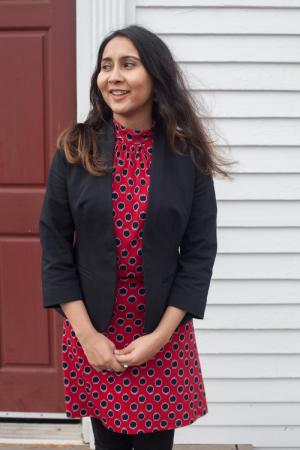 “I was drawn to Marlboro because it was an intentionally small school with an emphasis on teaching, and an openness to political aspects of literature,” says Rituparna Mitra, who joined Marlboro as professor of literature and writing in the fall. “But once I came here, then I noticed other things like the community, the way people interacted with one another—there was this closeness and at the same time freshness that I liked. And the independence that the students are encouraged to have—thinking of a long-term project, investing in it—that was something that struck me a lot. It’s a rare thing to find elsewhere.”
“I was drawn to Marlboro because it was an intentionally small school with an emphasis on teaching, and an openness to political aspects of literature,” says Rituparna Mitra, who joined Marlboro as professor of literature and writing in the fall. “But once I came here, then I noticed other things like the community, the way people interacted with one another—there was this closeness and at the same time freshness that I liked. And the independence that the students are encouraged to have—thinking of a long-term project, investing in it—that was something that struck me a lot. It’s a rare thing to find elsewhere.”
Rituparna has more than a decade of experience teaching literature and writing in both the US and India, including at Michigan State University where she received her PhD. Her dissertation examined South Asian representations of trauma from the Partition of 1947 and subsequent Hindu-Muslim conflict in India, offering a postcolonial and global understanding of what has mostly been a Eurocentric narrative. Rituparna’s expertise in the areas of global Anglophone literature, social and environmental justice, displacement and migration, and gender and ethnicity brings a transnational perspective to the exploration of literature and writing for Marlboro students.
“I’m here to teach teach global literature as well as postcolonial literature with a deep emphasis on colonization, and so my literature courses definitely address that element,” says Rituparna. In the fall she taught a course on Transnational and Diasporic Narratives, looking at the ways in which the history of colonization and cultural collisions continue to resonate in the way people think about themselves and their place in the world. She also taught a writing seminar on Narratives of Trauma and Witnessing.
“Traumas are often seen through an individual lens, and the Holocaust has been central to the way we think about shared trauma, especially in academics. So, I start at the Holocaust, but then I move on to postcolonialism traumas. I encourage people to think comparatively.” In the spring, Rituparna is excited to be teaching a course on the contemporary global novel. “We’ll be looking a lot at what makes a novel global, and what other worlds are possible.”
Rituparna has had to adjust to smaller class sizes, after teaching in larger classrooms for many years. She says that having fewer speakers in the room pushes her more as a teacher, and demands that she is on her toes at all times. On the other hand, when everyone is fully engaged it is like nothing she’s ever experienced before.
“It’s absolutely fabulous to have just six people in a room, but with an explosion of insights,” says Rituparna. “It’s such an intimate setting, with everybody that involved. I enjoy the different insights they all bring from their different Plans. They have so much experience already, and they’re sharing it from each of their perspectives. As a teacher I’m still constantly learning.”
As far as her own scholarly activities, Rituparna is currently preparing a book manuscript based on her dissertation, titled Postcolonial Trauma in South Asia: Body, Memory, and Displacement in Literature. One chapter has already been published in the edited collection The Postcolonial World, and another is to be published in the forthcoming Beyond Partition: Mediascapes and Literature in Post-colonial India, Pakistan, and Bangladesh. Rituparna is also working on a second book project that examines representations of global terrorism in South Asian Anglophone literature, where terrorism is linked to the failures of the postcolonial state and to uneven globalization.
Rituparna finds great inspiration in the peace and natural beauty of Marlboro, having spent most of her adult life in more urban areas. “Just being in a place that’s this beautiful, even when it’s gray and rainy, nurtures me in a sense. It feels magical, and nourishes creativity. I love that. So, on one hand, just the place— the physicality—but also the people I interact with. It’s such a joy to have intelligent, open-minded, aware people. I’m actually getting spoiled.”
William Ransom: Engaging with Materials
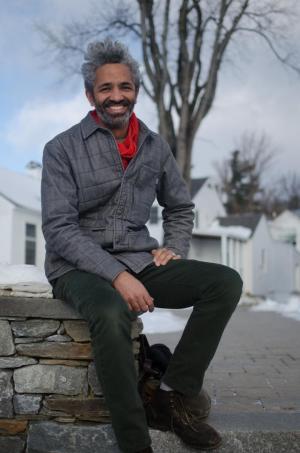 “Sculpture is often used as an umbrella term encompassing everything from carving stone or modeling clay to performance and video work—all of those things that exist beyond two-dimensional art,” says William Ransom, who joined Marlboro to teach sculpture and visual arts in the fall. “For myself, I have taught things that reach across that spectrum, all the way from direct material engagement to more installation-based stuff.”
“Sculpture is often used as an umbrella term encompassing everything from carving stone or modeling clay to performance and video work—all of those things that exist beyond two-dimensional art,” says William Ransom, who joined Marlboro to teach sculpture and visual arts in the fall. “For myself, I have taught things that reach across that spectrum, all the way from direct material engagement to more installation-based stuff.”
William was already familiar with Marlboro from years ago, when he was a Bennington College student and came to campus to play their perennial soccer rival. He also grew up in Strafford, Vermont, so after ten years on the West Coast, getting his MFA from Claremont Graduate University and teaching at Pomona College, Cal State San Bernardino, and California Institute of the Arts, he was eager to return to the Green Mountain State. A yearlong visiting professorship at Middlebury College only whet his appetite.
“Having grown up in Vermont, and now having kids, I started kind of stalking Marlboro College—in the best way—looking for job postings,” says William. “And when I saw the posting and dug a little bit deeper into the program, I was really smitten with the idea. The small size appeals to me because I like having a developed relationship with my students surrounding their work. That’s really valuable, and at bigger schools it’s hard to come by.”
William also likes the ability to plan his own curriculum and the potential for cross-pollination with other faculty members with overlapping interests. “One of the benefits about being in a small place is that nimbleness.”
When introducing students to sculpture, William starts from an embodied experience of material, asserting that there is a lot of useful information to be gleaned from paying attention to materials and direct material engagement with one’s hands and body. He often likes to start with clay because it is so receptive to manipulation in a way that wood or stone is not.
“Clay is immediately reflective of your engagement with it, and that immediacy gives feedback in the form of knowledge built into your body, if you are paying attention. I feel like students respond very well to the directness of that, as a point of entry. As you get further up on the ladder of learning about sculpture, the direct engagement leads to conceptual engagement, and materials run the spectrum from stone carving to installation, social sculpture, and performance-based work. I feel like material engagement is the way to open the door to those other more conceptually driven works and interacting with the audience—the caliber of student work is improved greatly by a broader material understanding.”
William’s own work often concerns issues of race and social justice, as well as sustainability, interaction with the natural world, and agricultural experience. He works with wood a lot, often testing its material potential in ephemeral installations that evoke dynamic tension between elements and invite audience participation.
“I really like the potential of the visceral encounter for the viewer,” says William, who has exhibited his work in galleries across the country, from New York, Detroit, and Chicago to California. Most recently, he was included in group exhibitions in Los Angeles and Santa Monica, California, and a solo exhibition titled Hem n’ Haw, in Hudson, New York. William was awarded a Windgate Fellowship at Vermont Studio Center in 2015, in addition to several other fellowships over the years.
William is excited about a class he’s teaching this spring close to his own interests, called Art’s Ghost: The Ephemeral and Letting Go. In addition to exploring the rise of ephemerality in contemporary art history, students will be exploring materials that, by design, don’t last— from snow and ice to installation and performance art.
“We’ll be thinking pretty broadly about what it means to make something that has a brief window of time in which it can be experienced or enjoyed, and questioning the preciousness of objects,” says William.
A self-described biracial farm-boy, William recognizes that there are some drawbacks to relocating from southern California to Vermont, notably the relative scarcity of cultural institutions and opportunities and the lack of racial diversity. But he is certain that Marlboro’s geographic location should not hinder students’ access to culture. “I have been pleasantly surprised, actually, at how much more diverse Vermont has become since I was a kid here.”
Library Rocks NEH Grants
The Rice-Aron Library was the proud recipient of two grants from the National Endowment for the Humanities (NEH) this year. Together, they stand to increase the library’s impact within the local community and make its valuable archives more accessible.
The first was a joint NEH and American Library Association grant to take part in the Great Stories Club, a program that supports reading and discussion programs for underserved teens. Partnering with the Boys and Girls Club of Brattleboro, Rice-Aron Library was one of 100 libraries in the US selected for this grant, one of only five college libraries, and the only grantee chosen in Vermont.
“We are excited to start our book club in January, with the theme ‘What Makes a Hero: Self, Society, and Rising to the Occasion,’” says library director Beth Ruane. “The books include an amazing range of perspectives, from Black Panther to Art Spiegelman’s Maus II, chosen to inspire teens to consider big questions about the world and their place in it.”
The second NEH award is a Preservation Assistance Grant, designed to help small institutions improve their ability to preserve and care for significant humanities collections. The Rice-Aron archives are one such collection, composed of printed materials on paper, images, audio and video tapes, and historical ephemera stretching back to the founding of the college.
“Marlboro’s first students, most of whom were veterans, indelibly shaped Marlboro’s uniquely self-directed, self-governed, and self-reliant identity,” says Beth. “These primary source materials have great value to scholars and students studying in a wide range of areas, including the history of higher education in America, the post-WWII era, and the veteran experience.”
Rice-Aron’s archives were the subject of last year’s course titled History of Universities and the Liberal Arts, which focused on the history of Marlboro and its place in wider debates about the role and purpose of higher education. Students spent every other Thursday working in the archives to create more-specific subject categories for ease of finding, and shared some rare discoveries with the community through social media.
“Unfortunately, Marlboro has never been in a position to have a full-time archivist on its staff,” says Beth. “As a result, though the collecting of materials created by students, faculty, and administrative and departmental staff has been enthusiastic, knowing exactly what is held in the archives, let alone locating an item in a timely fashion, is nearly impossible.”
The first step of an ambitious project to improve stewardship and increase internal and external access to the college archives, the NEH grant will enable Beth to take classes at Simmons College in the area of Special Collections and Archives. “This training will position me to be a more effective steward of the college’s archives, able to develop realistic and appropriate planning for the assessment, processing, and ongoing care of this important collection.”
Home Days Enliven Hill
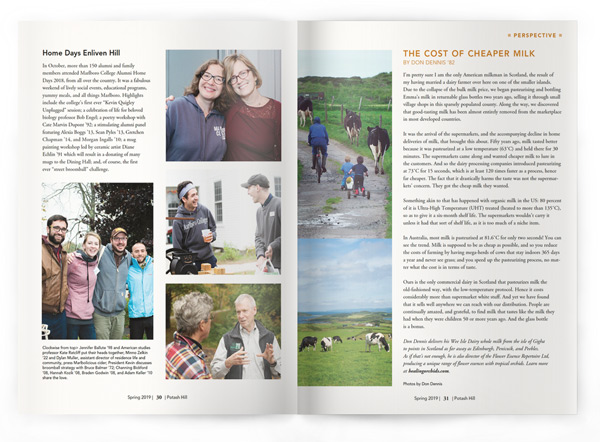
In October, more than 150 alumni and family members attended Marlboro College Alumni Home Days 2018, from all over the country. It was a fabulous weekend of lively social events, educational programs, yummy meals, and all things Marlboro. Highlights include the college’s first ever “Kevin Quigley Unplugged” session; a celebration of life for beloved biology professor Bob Engel; a poetry workshop with Cate Marvin Dupont ’92; a stimulating alumni panel featuring Alexia Boggs ’13, Sean Pyles ’13, Gretchen Chapman ’14, and Morgan Ingalls ’10; a mug painting workshop led by ceramic artist Diane Echlin ’91 which resulted in a donating of many mugs to the Dining Hall; and, of course, the first ever “street broomball” challenge.
Photos on left page above, clockwise from top> Jennifer Ballute ’98 and American studies professor Kate Ratcliff put their heads together; Minno Zelkin ’22 and Dylan Muller, assistant director of residence life and community, press Marlbolicious cider; President Kevin discusses broomball strategy with Bruce Balmer ’72; Channing Bickford ’08, Hannah Kozik ’08, Braden Godwin ’08, and Adam Keller ’10 share the love.
Events
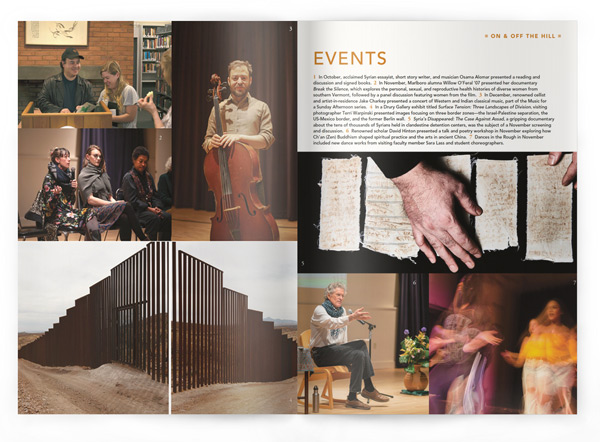
1 In October, acclaimed Syrian essayist, short story writer, and musician Osama Alomar presented a reading and discussion and signed books. 2 In November, Marlboro alumna Willow O’Feral ’07 presented her documentary Break the Silence, which explores the personal, sexual, and reproductive health histories of diverse women from southern Vermont, followed by a panel discussion featuring women from the film. 3 In December, renowned cellist and artist-in-residence Jake Charkey presented a concert of Western and Indian classical music, part of the Music for a Sunday Afternoon series. 4 In a Drury Gallery exhibit titled Surface Tension: Three Landscapes of Division, visiting photographer Terri Warpinski presented images focusing on three border zones—the Israel-Palestine separation, the US-Mexico border, and the former Berlin wall. 5 Syria’s Disappeared: The Case Against Assad, a gripping documentary about the tens of thousands of Syrians held in clandestine detention centers, was the subject of a November screening and discussion. 6 Renowned scholar David Hinton presented a talk and poetry workshop in November exploring how Ch’an (Zen) Buddhism shaped spiritual practice and the arts in ancient China. 7 Dances in the Rough in November included new dance works from visiting faculty member Sara Lass and student choreographers.
Focus on Faculty
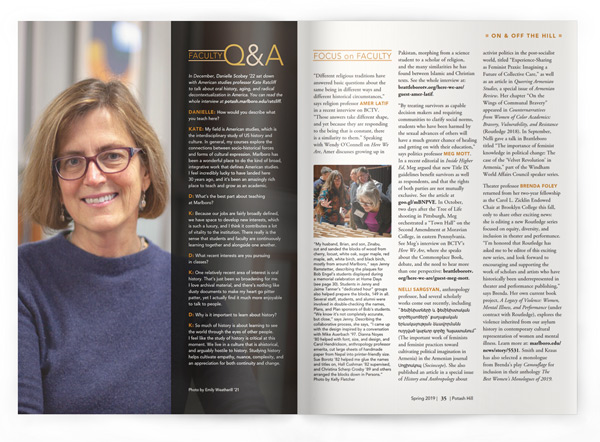
Faculty Q&A
In December, Danielle Scobey ’22 sat down with American studies professor Kate Ratcliff to talk about oral history, aging, and radical decontextualization in America. You can read the whole interview at potash.marlboro.edu/ratcliff.
Danielle: How would you describe what you teach here?
Kate: My field is American studies, which is the interdisciplinary study of US history and culture. In general, my courses explore the connections between socio-historical forces and forms of cultural expression. Marlboro has been a wonderful place to do the kind of broad, integrative work that defines American studies. I feel incredibly lucky to have landed here 30 years ago, and it’s been an amazingly rich place to teach and grow as an academic.
D: What’s the best part about teaching at Marlboro?
K: Because our jobs are fairly broadly defined, we have space to develop new interests, which is such a luxury, and I think it contributes a lot of vitality to the institution. There really is the sense that students and faculty are continuously learning together and alongside one another.
D: What recent interests are you pursuing in classes?
K: One relatively recent area of interest is oral history. That’s just been so broadening for me. I love archival material, and there’s nothing like dusty documents to make my heart go pitter patter, yet I actually find it much more enjoyable to talk to people.
D: Why is it important to learn about history?
K: So much of history is about learning to see the world through the eyes of other people. I feel like the study of history is critical at this moment. We live in a culture that is ahistorical, and arguably hostile to history. Studying history helps cultivate empathy, nuance, complexity, and an appreciation for both continuity and change.
Photo by Emily Weatherill ’21
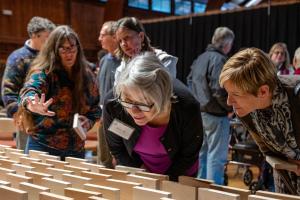 “Different religious traditions have answered basic questions about the same being in different ways and different historical circumstances,” says religion professor Amer Latif in a recent interview on BCTV. “Those answers take different shape, and yet because they are responding to the being that is constant, there is a similarity to them.” Speaking with Wendy O’Connell on Here We Are, Amer discusses growing up in Pakistan, morphing from a science student to a scholar of religion, and the many similarities he has found between Islamic and Christian texts. See the whole interview.
“Different religious traditions have answered basic questions about the same being in different ways and different historical circumstances,” says religion professor Amer Latif in a recent interview on BCTV. “Those answers take different shape, and yet because they are responding to the being that is constant, there is a similarity to them.” Speaking with Wendy O’Connell on Here We Are, Amer discusses growing up in Pakistan, morphing from a science student to a scholar of religion, and the many similarities he has found between Islamic and Christian texts. See the whole interview.
“By treating survivors as capable decision makers and requiring communities to clarify social norms, students who have been harmed by the sexual advances of others will have a much greater chance of healing and getting on with their education,” says politics professor Meg Mott. In a recent editorial in Inside Higher Ed, Meg argued that new Title IX guidelines benefit survivors as well as respondents, and that the rights of both parties are not mutually exclusive. See the article. In October, two days after the Tree of Life shooting in Pittsburgh, Meg orchestrated a “Town Hall” on the Second Amendment at Moravian College, in eastern Pennsylvania. See Meg’s interview on BCTV’s Here We Are, where she speaks about the Commonplace Book, debate, and the need to hear more than one perspective.
Nelli Sargsyan, anthropology professor, had several scholarly works come out recently, including “Ֆեմինիստների և ֆեմինիստական գործելաոճերի` քաղաքական երևակայության ձևավորմանն ուղղված կարևոր գործը Հայաստանում” (The important work of feminists and feminist practices toward cultivating political imagination in Armenia) in the Armenian journal Սոցիոսկոպ (Socioscope). She also published an article in a special issue of History and Anthropology about activist politics in the post-socialist world, titled “Experience-Sharing as Feminist Praxis: Imagining a Future of Collective Care,” as well as an article in Queering Armenian Studies, a special issue of Armenian Review. Her chapter “On the Wings of Communal Bravery” appeared in Counternarratives from Women of Color Academics: Bravery, Vulnerability, and Resistance (Routledge 2018). In September, Nelli gave a talk in Brattleboro titled “The importance of feminist knowledge in political change: The case of the ‘Velvet Revolution’ in Armenia,” part of the Windham World Affairs Council speaker series.
Theater professor Brenda Foley returned from her two-year fellowship as the Carol L. Zicklin Endowed Chair at Brooklyn College this fall, only to share other exciting news: she is editing a new Routledge series focused on equity, diversity, and inclusion in theater and performance. “I’m honored that Routledge has asked me to be editor of this exciting new series, and look forward to encouraging and supporting the work of scholars and artists who have historically been underrepresented in theater and performance publishing,” says Brenda. Her own current book project, A Legacy of Violence: Women, Mental Illness, and Performance (under contract with Routledge), explores the violence inherited from our asylum history in contemporary cultural representation of women and mental illness. Learn more. Smith and Kraus has also selected a monologue from Brenda’s play Camouflage for inclusion in their anthology The Best Women’s Monologues of 2019.
“Brattleboro is one of three locations where we’re gathering Vermonters together,” says management faculty member Kerry Secrest, referring to a Vermont Commission on Women’s Listening Project event titled “The Hidden Side of Women’s Lives in Our Community.” The statewide Listening Project survey asks what needs aren’t being met for Vermont women, what most affects their abilities to provide for themselves or their families, and what can be done to help. “This is an opportunity for community members to shape the work of our commission,” says Kerry, one of the Brattleboro commissioners who hosted the event. “We want to listen to the real-world experiences of women in our community, their stories, and the challenges they encounter in their everyday lives.”
Photography professor John Willis presented an exhibit titled “Mni Wiconi: Honoring the Water Protectors” at Cynthia Reeves Contemporary Art Gallery, in North Adams, Massachusetts; Southeast Florida Community College; Green Mountain College; and Keene State College. In November, John was one of six Vermont artists honored by the Vermont Arts Council at a ceremony in Montpelier. John received the Ellen McCulloch-Lovell Award in Arts Education, named for Marlboro’s retired president. Learn more. But John is most animated about the purchase of a new 3,300-square-foot space in Brattleboro by In-Sight Photography Project, the youth arts program he co-founded. “We will move the program over and have a larger, safer, up to date, and fully accessible teaching space. Marlboro students have been teaching and volunteering there for 26 years and will continue. Yeah!”
Rituparna Mitra, Marlboro’s new professor of writing and literature, presented in two panels at the Modern Languages Association Annual Conference held in January in Chicago. She presented her paper titled “Postcolonial ecologies and embodied memory in Amitav Ghosh’s The Hungry Tide and Akhtaruzzaman Elias’s Khoabnama” on the panel on Textual Transactions in Bangladeshi/ Bengali Literature. Her paper titled “Precarious Duniyas: Posthuman subjectivity and politics in The Ministry of Utmost Happiness” was featured on the panel on The Global South Novel. Also in January, Rituparna presented her paper titled “The ghazal and the gathering of worlds in Ali’s ‘The Country without a Post Office’” at the meeting of the South Asian Literary Association in Chicago.
Rosario DeSwanson, professor of Spanish language and literature and gender studies, presented her new book “¿Y cuál es mi lugar, señor, entre tus actos?”: El drama de Rosario Castellanos (Peter Lang, 2018) at Keene State University and Bennington College. “Although there are numerous studies that engage with the work of Mexican feminist Rosario Castellanos, most center on her narrative prose, poetry, or essays. My book addresses this vacuum, offering scholars a complete study of all of her plays while it traces her ideas regarding the place of female intellectuals within the nation, as her first drama coincides with her decision to become a writer.” The book received advanced praise from Velma Garcia, professor of government and Latin American and Latino studies from Smith College, and from Gene Bell-Villada, professor of romance languages at Williams College. See the book.
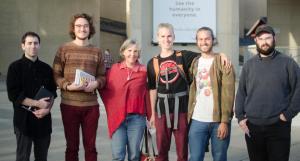 “It’s a place that resonates with these iconic images that are very fertile in the American imagination— the clearing in the woods and the hilltop setting,” says President Kevin Quigley, referring to Marlboro College in a September article in The Chronicle of Higher Education. “Both are rich metaphors for the establishment of a community, particularly a learning community.” The special report highlights Marlboro’s bucolic setting, sense of community, and the ability of students to effect change through shared governance. It also touches on the college’s recent struggles with enrollment and financial setbacks, shared by many other small colleges, but emphasizes the college’s many strengths being brought to bear on issues.
“It’s a place that resonates with these iconic images that are very fertile in the American imagination— the clearing in the woods and the hilltop setting,” says President Kevin Quigley, referring to Marlboro College in a September article in The Chronicle of Higher Education. “Both are rich metaphors for the establishment of a community, particularly a learning community.” The special report highlights Marlboro’s bucolic setting, sense of community, and the ability of students to effect change through shared governance. It also touches on the college’s recent struggles with enrollment and financial setbacks, shared by many other small colleges, but emphasizes the college’s many strengths being brought to bear on issues.
Ian McManus, Marlboro’s new professor of economics, had an article accepted for publication in the Journal of Common Market Studies. Titled “The reemergence of partisan effects on social spending in Europe after the global financial crisis,” the article analyzes how the politics of social spending changed after the Great Recession in Europe and other advanced welfare states. Ian is also working on a manuscript of his dissertation and other articles on the politics of social and economic policymaking across countries. “This work highlights vital issues, including the distributional effects of the Great Recession, the effects of international institutions on domestic policies, the influence of political parties and ideologies on social spending, and the negative effects of inequality on economic growth and social well-being,” he said.
Theater and gender studies professor Jean O'Hara published an article titled “Unsettling the Frontier Fable” in the September 2018 issue of Q2Q: Queer Canadian Theatre and Performance. In November, Jean and her colleague (and last May’s commencement speaker) Shaunna Oteka McCovey were awarded a grant from Theatre Communications Group, as part of its Global Connections program supported by the Andrew W. Mellon Foundation. “We will create a play adaptation of the book In the Land of the Grasshopper Song: Two Women in the Klamath River Indian Country in 1908-09,” says Jean. “Although the book is a historical account of early contact between the Karuk Nation and European-Americans, it is ultimately written from a white perspective. It is our intention to write it from a Karuk perspective that also includes the Karuk language.” Jean and Shaunna (who is Yurok and Karuk) will co-create the play while also organizing events that allow for Karuk Tribal member participation.
Bronwen Tate, professor of writing and literature, published a poem in the October issue of About Place Journal, which is on the theme of Roots and Resistance, titled “By Gift, Purchase, Capture, or Inheritance." She published a handful of poems in the tiny mag as well, and an essay called “‘The Narrative No Longer Just Contains It Involves’: Frank Stanford’s Collective Visions” in the anthology Constant Stranger: After Frank Stanford. “I also gave poetry readings and talks at the Frank Stanford Literary Festival in Fayetteville, Arkansas, and the Stanford University DARE@10 Homecoming in Palo Alto, California,” says Bronwen.
Philosophy and environmental studies professor William Edelglass has several pieces forthcoming, including “The Ethics of Difference and Singularity: Levinas, Responsibility, and Climate Change,” in Moral Theory and Climate Change: Ethical Perspectives on a Warming Planet, edited by Dale E. Miller and Ben Eggleston, Routledge, 2019; and “Aspiration, Conviction, and Serene Joy: Faith and Reason in Indian Buddhist Literature on the Path,” forthcoming in Beyond Faith Versus Reason: Cross-Cultural Perspectives on the Philosophy of Religion, edited by Sonia Sikka and Ashwani Peetush. William was a guest on a recent episode of the Imperfect Buddha Podcast, and in September his work was profiled in an interview with Richard Marshall in 3:AM Magazine (see an excerpt in this Potash Hill).
Also of Note
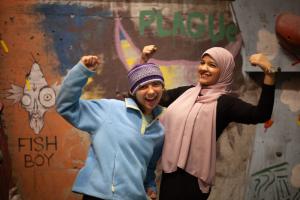 “Community service forms a very important part of life at Marlboro, and I’m very glad to be a part of it this year,” said Lamia Barakat, Marlboro’s Fulbright Arabic language fellow (pictured with sophomore Alyssa Strobele). She was invited to share her perspective on community service at Marlboro at a Fulbright conference in Washington, DC, in December. In a video presented at the conference, Lamia describes painting a local ski hut, gardening on campus, doing trail work, and maintaining the climbing wall alongside students and other community members. She also interviews President Kevin, who shares his perspective on the history of community service at Marlboro. Learn more.
“Community service forms a very important part of life at Marlboro, and I’m very glad to be a part of it this year,” said Lamia Barakat, Marlboro’s Fulbright Arabic language fellow (pictured with sophomore Alyssa Strobele). She was invited to share her perspective on community service at Marlboro at a Fulbright conference in Washington, DC, in December. In a video presented at the conference, Lamia describes painting a local ski hut, gardening on campus, doing trail work, and maintaining the climbing wall alongside students and other community members. She also interviews President Kevin, who shares his perspective on the history of community service at Marlboro. Learn more.
Surprisingly, in October Marlboro College was mentioned in the U.S. News & World Report’s list of the 10 colleges with the most undergraduates. “The University of Central Florida tops the list with nearly 57,000...more than 300 times the enrollment at the ranked school with the fewest undergraduates: Marlboro College in Vermont, which only had 183 students.” What they fail to mention is that Marlboro’s faculty-student ratio is 5:1, as opposed to UCF’s 30:1, or that there are more than two acres per student at Marlboro while UCF students get a mere 1,300 square feet. Do they have a cookie drawer, or a wood-fired sauna?
During the fall, juniors Menefese Kudumu-Clavell, Ricarrdo Valentine, and Nicktae Marroquin-Haslett were all on a semester exchange at Marlboro’s newest international partner school, Autonomous University of San Luis Potosí, in México. “I feel like I’ve expanded as an artist, as a result of my time there,” said Ricarrdo, who is working on a Plan in dance and photography focusing on Afro-Mexican identity and dance. “I was able to explore other cross-collaborative media, and try new ideas.” Ricarrdo also had the opportunity to set up an internship for next fall in Veracruz, creating dance with youth and collaborating with an anthropologist there, a connection made through anthropology professor Nelli Sargsyan.
“Studying abroad isn’t always about making your imagination into reality; sometimes it’s about going deeper into the experience that’s already in front of you,” says junior Alta Millar. Alta spent the fall semester at the Trinity Laban Conservatoire of Music and Dance, located in southeast London, studying contemporary dance and choreography. “What was so exciting for me was that my dancers knew exactly what I wanted. I was using Laban notation terminology to describe the movement. With this shared language, they were able to pick it up instantly and visualize my ideas in real time.” See Alta’s blog posts.
Longtime financial aid director Cathy Fuller was appointed to the position of registrar in July, capping more than 19 years of working at Marlboro, having started out in student accounts for almost five years, then in financial aid for 14. “My favorite part of being registrar is celebrating successes with students, whether it’s graduating, meeting a deadline they didn’t think they could meet, or hearing about courses they are so excited about.” She also likes working more closely with faculty, but misses her colleague Jayne Rivers, who she worked with for many years. “The other thing I miss is the federal guidelines—call me crazy but I liked the legal aspect of them.”
“Marlboro has worked hard over the years to ensure that we have dealt with Title IX cases fairly, thoroughly, and with respect to our shared community values of safety, learning, and inclusiveness,” said President Kevin in a December letter to the community. The letter was in response to new Title IX regulations proposed by the U.S. Department of Education that would require significant changes in how Marlboro addresses claims of sexual harassment, sexual assault, and other rights violations. While the new regulations have yet to be made law, the letter shares the college’s initial reactions and plans for addressing the proposed regulations. Read the letter.
River Run 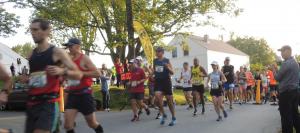 On the morning of August 26, the inaugural New England Green River Marathon started at Marlboro College—an auspicious start for the academic year. “Getting the most out of your college years is a marathon in a very real sense, and it seemed fitting for Marlboro to sponsor and host the beginning of this pioneering race,” said President Kevin. Learn more.
On the morning of August 26, the inaugural New England Green River Marathon started at Marlboro College—an auspicious start for the academic year. “Getting the most out of your college years is a marathon in a very real sense, and it seemed fitting for Marlboro to sponsor and host the beginning of this pioneering race,” said President Kevin. Learn more.
Source to Sea 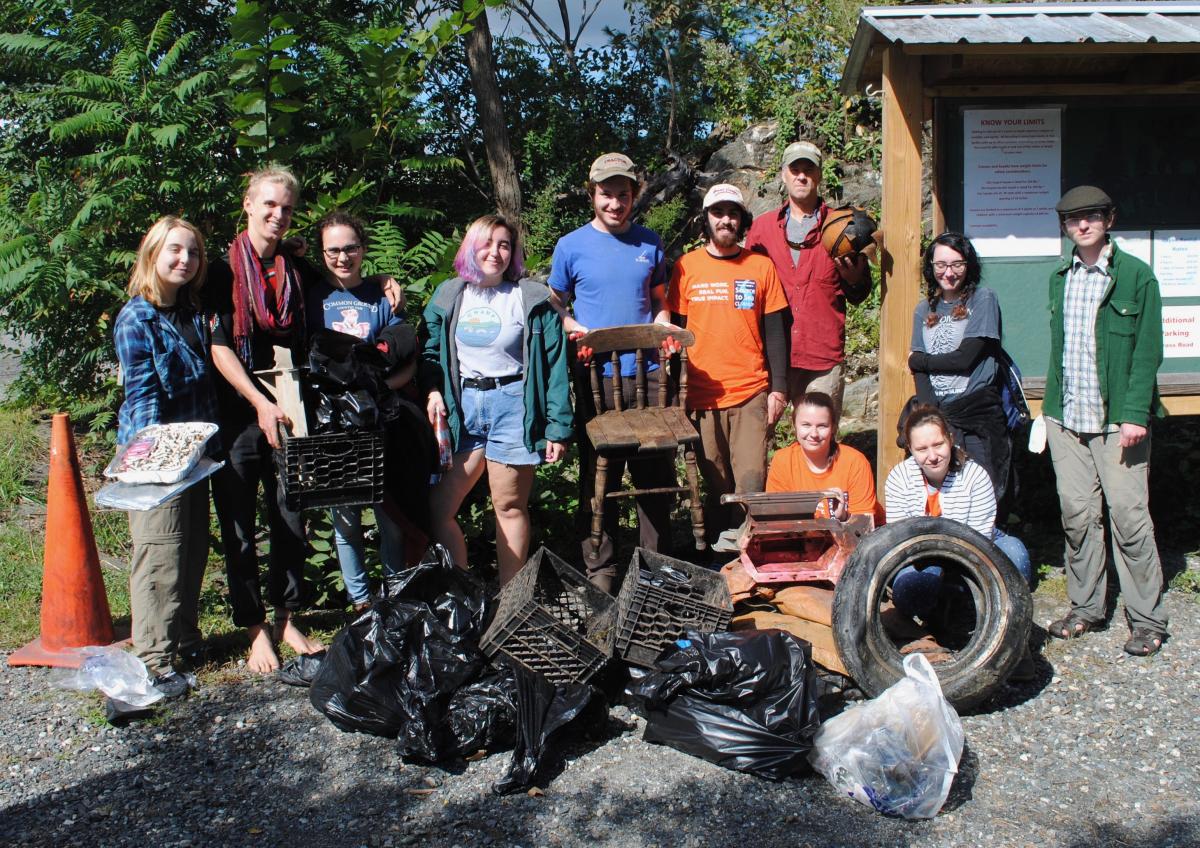 In September, several students joined chemistry professor Todd Smith for the Connecticut River Conservancy’s Source to Sea Cleanup, part of the 2,853 volunteers who removed 46 tons of trash from 174 miles of the river.
In September, several students joined chemistry professor Todd Smith for the Connecticut River Conservancy’s Source to Sea Cleanup, part of the 2,853 volunteers who removed 46 tons of trash from 174 miles of the river.
Quill to Live 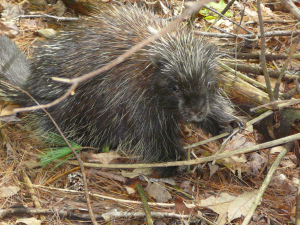 Found lying by a road on campus last September, this porcupine was treated for two weeks by nearby wildlife rehabilitator Patti Smith. “She was returned to the college and is doing just fine, eating raspberry leaves, that is, not taking exams,” says Patti, a naturalist at Bonnyvale Environmental Education Center. Photo by Patti Smith
Found lying by a road on campus last September, this porcupine was treated for two weeks by nearby wildlife rehabilitator Patti Smith. “She was returned to the college and is doing just fine, eating raspberry leaves, that is, not taking exams,” says Patti, a naturalist at Bonnyvale Environmental Education Center. Photo by Patti Smith
Think Ice 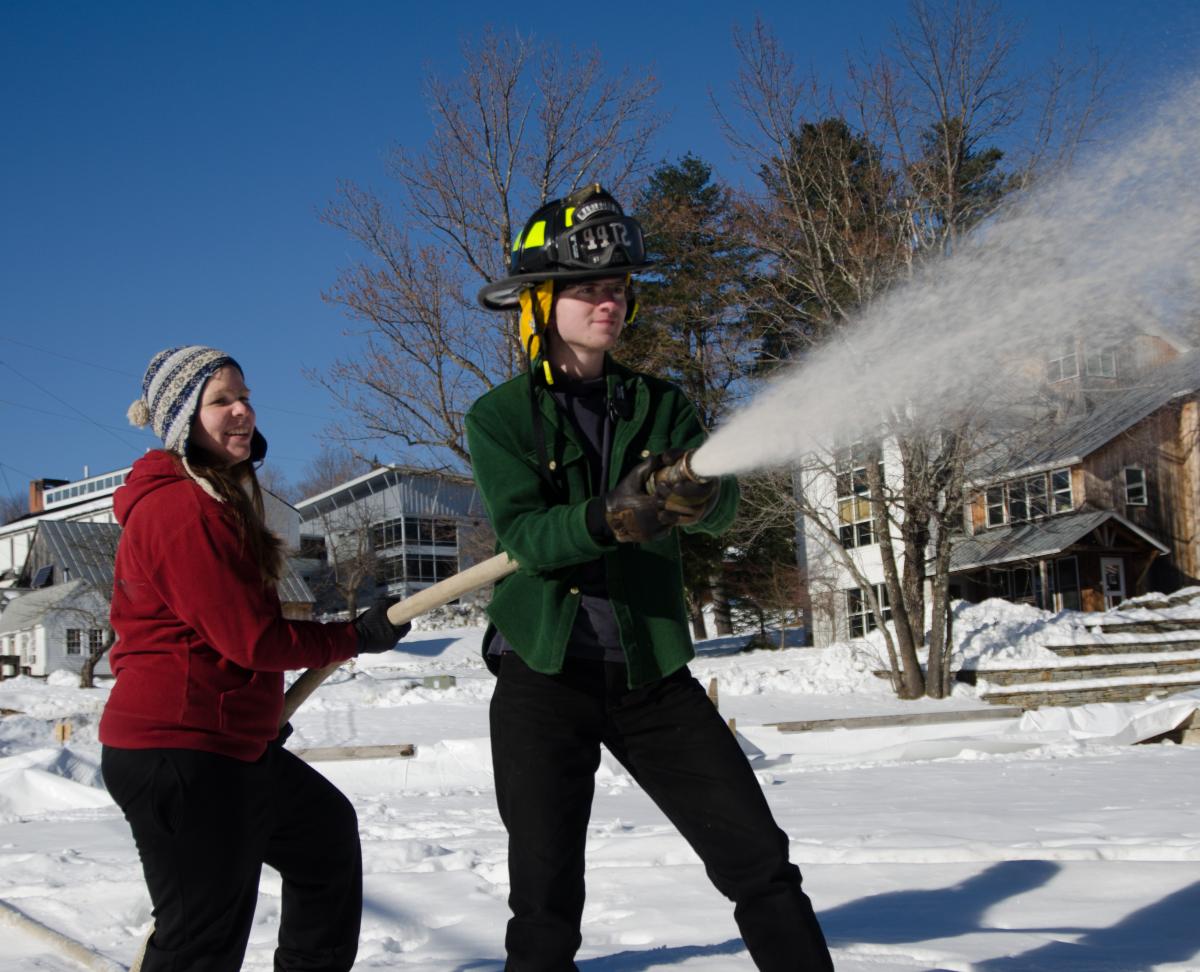 The Outdoor Program moved the location for the skating rink from the soccer field to a more central location in the meadow below the Campus Center, with the help of Hannah Anderson, coordinator for student activities and recreation, and senior Daniel Madeiros.
The Outdoor Program moved the location for the skating rink from the soccer field to a more central location in the meadow below the Campus Center, with the help of Hannah Anderson, coordinator for student activities and recreation, and senior Daniel Madeiros.
Clear Writing Fuel 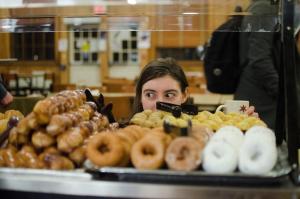 First year student Emmanuel Miller considers her options during Midnight Breakfast, the traditional festive meal on the night before writing portfolios are due.
First year student Emmanuel Miller considers her options during Midnight Breakfast, the traditional festive meal on the night before writing portfolios are due.
Alumni News
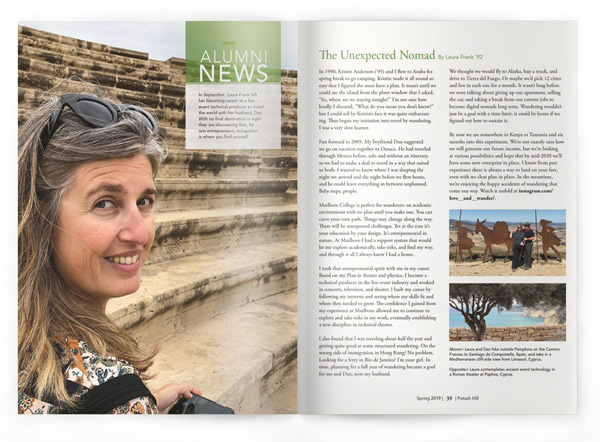
The Unexpected Nomad
By Laura Frank ’92
In September, Laura Frank left her blooming career as a live event technical producer to travel the world with her husband, Dan. With no final destination in sight they are discovering that, for arts entrepreneurs, occupation is where you find yourself.
In 1990, Kristin Anderson (’95) and I flew to Aruba for spring break to go camping. Kristin made it all sound so easy that I figured she must have a plan. It wasn’t until we could see the island from the plane window that I asked, “So, where are we staying tonight?” I’m not sure how loudly I shouted, “What do you mean you don’t know?” but I could tell by Kristin’s face it was quite embarrassing. Thus began my initiation into travel by wandering. I was a very slow learner.
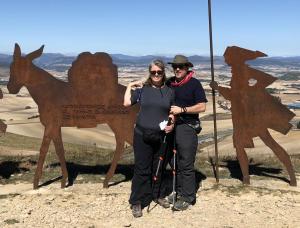 Fast forward to 2005. My boyfriend Dan suggested we go on vacation together to Oaxaca. He had traveled through Mexico before, solo and without an itinerary, so we had to make a deal to travel in a way that suited us both. I wanted to know where I was sleeping the night we arrived and the night before we flew home, and he could leave everything in between unplanned. Baby steps, people.
Fast forward to 2005. My boyfriend Dan suggested we go on vacation together to Oaxaca. He had traveled through Mexico before, solo and without an itinerary, so we had to make a deal to travel in a way that suited us both. I wanted to know where I was sleeping the night we arrived and the night before we flew home, and he could leave everything in between unplanned. Baby steps, people.
Marlboro College is perfect for wanderers: an academic environment with no plan until you make one. You can carve your own path. Things may change along the way. There will be unexpected challenges. Yet at the core it’s your education by your design. It’s entrepreneurial in nature. At Marlboro I had a support system that would let me explore academically, take risks, and find my way, and through it all I always knew I had a home.
I took that entrepreneurial spirit with me in my career. Based on my Plan in theater and physics, I became a technical producer in the live event industry and worked in concerts, television, and theater. I built my career by following my interests and seeing where my skills fit and where they needed to grow. The confidence I gained from my experience at Marlboro allowed me to continue to explore and take risks in my work, eventually establishing a new discipline in technical theater.
I also found that I was traveling about half the year and getting quite good at some structured wandering. On the wrong side of immigration in Hong Kong? No problem. Looking for a ferry in Rio de Janeiro? I’m your girl. In time, planning for a full year of wandering became a goal for me and Dan, now my husband.
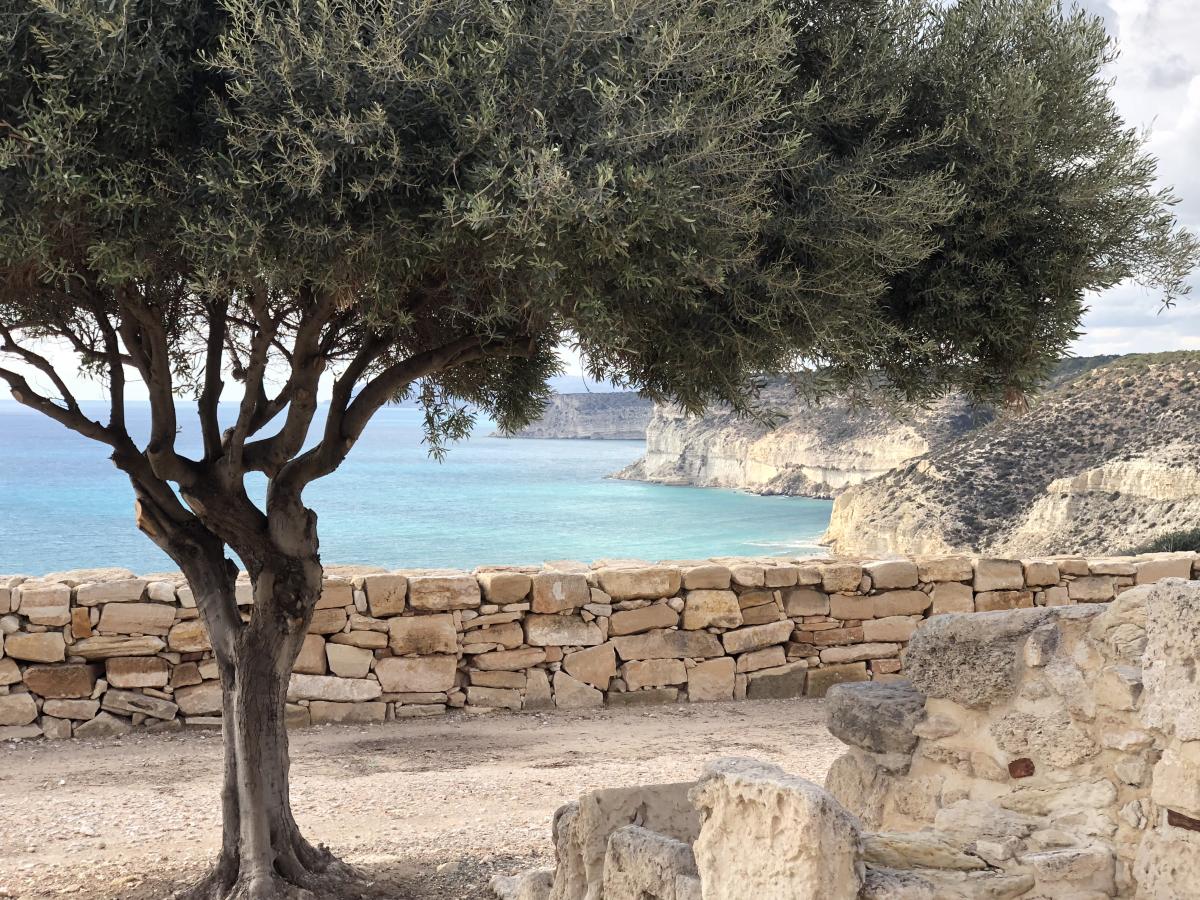 We thought we would fly to Alaska, buy a truck, and drive to Tierra del Fuego. Or maybe we’d pick 12 cities and live in each one for a month. It wasn’t long before we were talking about giving up our apartment, selling the car, and taking a break from our current jobs to become digital nomads long term. Wandering wouldn’t just be a goal with a time limit, it could be home if we figured out how to sustain it.
We thought we would fly to Alaska, buy a truck, and drive to Tierra del Fuego. Or maybe we’d pick 12 cities and live in each one for a month. It wasn’t long before we were talking about giving up our apartment, selling the car, and taking a break from our current jobs to become digital nomads long term. Wandering wouldn’t just be a goal with a time limit, it could be home if we figured out how to sustain it.
By now we are somewhere in Kenya or Tanzania and six months into this experiment. We’re not exactly sure how we will generate our future income, but we’re looking at various possibilities and hope that by mid-2020 we’ll have some new enterprise in place. I know from past experience there is always a way to land on your feet, even with no clear plan in place. In the meantime, we’re enjoying the happy accidents of wandering that come our way. Watch it unfold at instagram.com/love__and__wander/.
Class Notes
Class notes are listed by year and include both graduates and nongraduates; the latter are listed under the class with which they are associated.
’63 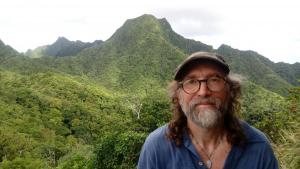 “I recently published a book of poetry titled Inside Outside, available on Amazon,” says JONATHAN POTTER. “I’m close to completing my class in history of the theater at UMA-Rockland. There are a good number of students this year, and the director has asked that the course be taught again in the fall.”
“I recently published a book of poetry titled Inside Outside, available on Amazon,” says JONATHAN POTTER. “I’m close to completing my class in history of the theater at UMA-Rockland. There are a good number of students this year, and the director has asked that the course be taught again in the fall.”
’68
“People always talk about how horrible old age is, but I couldn’t disagree more,” says writer DEBORAH EISENBERG in a feature profile in the New York Times Magazine subtitled “Chronicle of American Insanity.” “I find age is as intense as adolescence. You know you could hurtle off a cliff at any second. And because of that there’s a sense of destiny, of apprehending things, of love that isn’t available—or wasn’t available to me—earlier. You feel: I’ve survived this ordeal, and now I don’t have to worry. I know how my life has worked out. All the anxiety that I put into the hard questions has fallen away. I can take my satisfactions where they are.” Learn more.
’70
BILL BARKENTIN shares that several pieces of antique furniture collected by him and PETER DEVEIKIS ’71 over more than three decades were part of an exhibition at the Massachusetts Historical Society titled “Entrepreneurship and Classical Design in Boston’s South End: The Furniture of Isaac Vose & Thomas Seymour, 1815 to 1825.” In a cover story about the exhibition in Antiques and the Arts Weekly, the “vast private collection” referred to is Bill and Peter’s. “I find it gratifying that Peter’s great scholarship, pioneering interest in classical furniture, and wonderful collector’s eye are receiving this recognition. I think he would be pleased,” writes Bill.
’82
ABBY JACOBSON says, “For the past two and a half years, I’ve been working as a program coordinator at a small nonprofit called Putney Community Cares. We recently merged with Putney Family Services, which allows us to work with Putney residents of all ages, so I look forward to collaborating with our local schools, residents, and families, to name but a few.”
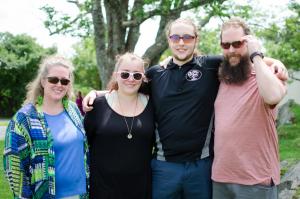 “My work is all about a reinterpretation of nature,” says DAVID LITTLE, in an August article in the New Hampshire Union Leader titled “Man of Steel: Meredith Blacksmith Forges Ahead.” Learn more.
“My work is all about a reinterpretation of nature,” says DAVID LITTLE, in an August article in the New Hampshire Union Leader titled “Man of Steel: Meredith Blacksmith Forges Ahead.” Learn more.
’86
“Greetings all from San Francisco,” writes BRIAN RICHARD. “Wow, 23 years? And back in Haight Ashbury, where I started from. I moved here from Miami Beach, Florida, in 1995, so I guess I like the oceans. Someday will learn to surf, soon I hope...I did graduate with an RHIT (Registered Health Information Technology) from AHIMA and obtained certifications in ICD-9-CM and CPT-4 codings, so time shall tell. Hope Vermont winter is tolerable, and the snow flows well with the maple syrup.”
“From climate change to species extinction, humanity is confronted with an increasing array of societal and environmental challenges that defy simple quantifiable solutions,” says the description of CHARLES CURTIN’s new book, Complex Ecology (Cambridge University Press, 2018, co-edited by T. H. F. Allen). “Complexity-based ecology provides a new paradigm for ecologists and conservationists keen to embrace the uncertainty that is pressed upon us.”
Samuel Dowe-Sandes ’96: Making Tiles in Marrakech 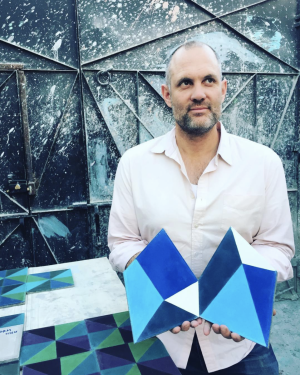 “I grew up in a house surrounded by beauty, which certainly helped lead me to where I am, despite not having any formal design training,” says Samuel Dowe-Sandes, son of local artists Roger Sandes and Mary Welsh. Together with his wife, Caitlin, in 2007 Samuel founded Popham Design, a design studio and tile workshop based in Marrakech, Morocco, following a yearlong sabbatical there.
“I grew up in a house surrounded by beauty, which certainly helped lead me to where I am, despite not having any formal design training,” says Samuel Dowe-Sandes, son of local artists Roger Sandes and Mary Welsh. Together with his wife, Caitlin, in 2007 Samuel founded Popham Design, a design studio and tile workshop based in Marrakech, Morocco, following a yearlong sabbatical there.
“We bought and renovated a small house and discovered a wide variety of Moroccan artisanal crafts, including handmade concrete tiles,” says Samuel. “We loved the product, but decided it would be fun to add our own contemporary designs to a traditional manufacturing process. By the end of our sabbatical we had already finished a business plan and were approaching investors and distributors.”
Now Popham’s tiles are exported throughout the world, adorning hotels, restaurants, and residences from San Francisco to Sydney, and have received international coverage from high-profile design and fashion magazines like Architectural Digest and Elle. Samuel loves a lot of things about being an entrepreneur, but especially enjoys bridging a traditional Moroccan craft with a contemporary design sense. He and Caitlin have learned a lot more about Morocco by having a business there.
“We’ve met a lot of interesting people along the way, and have tried to learn from all of them,” says Samuel, who also credits his Marlboro experience with preparing him for the entrepreneurial life. “Marlboro helped me hone the ability to look at a problem from many points of view. Running a business means dealing with a lot of questions, and being a critical thinker is key to that.”
’90
MARK ROESSLER’s new book, A Panoramic Tour of the Northampton State Hospital, came out in November from Levellers Press. This is a unique document of the historic building that was demolished in 2006. The book includes over 50 panoramas circumnavigating the original structure and looking inside. Learn more.
“I am currently in Kazakhstan, serving at the US Embassy,” says JOHN SURFACE. “I’ve been with the State Department for 13 years, cutting a swath through the belt of transition states in Eastern Europe, the Balkans, the former Soviet Union, and Central Asia. As with all roads we find ourselves wandering down, I can recall how I got here but never can pinpoint a conscious decision that forged the route. I stare at the regional map on occasion, wondering if the path is more Silk Road or Trans-Siberian Railway. There’s a smattering of old world Islamic architecture, kebab huts, and post-Soviet apartment blocks on the older streets here in Astana surrounded by the Dubai-meets-Vegas triumphalism and ornamental promenades of Nazarbayev’s new science-fiction capital. Utterly weird, thoroughly unique. This journey all began with seven years teaching in Poland, starting in 1995, first at the University of Gdansk, then as director of the American School of Gdynia. It’s now 23 years later into this life on the road, and I don’t feel a day over 25. In my head. The kids are 16 and 10, and our daughter will finish high school here. I know I have been busy. There have been years of toil and travel and wonder. I have no idea where all the years went. But I do know that my years at Marlboro set me down this path, and that Robert Frost described this sensation best. As did the Talking Heads.”
“I’m excited to be a part of innovation around the rural economy, in the usual areas of forestry and agriculture of course but also in the digital and creative economies,” said SARA COFFEY, who was elected to serve in the Vermont House of Representatives in November. “I’m looking forward to learning how to get things done, how to pull the levers, figuring out the systems, build collaboration.” Learn more.
’92 ALEX GARDNER reports, “I have a book coming out in May, The Life of Jamgon Kongtrul the Great, from Shambhala Publications. He was a highly influential Tibetan religious leader of the nineteenth century. It’s a full-length biography that gets into the weeds of how he trained, achieved renown, and interacted with the people and historical events of his era.” Learn more at shambhala.com/life-of-jamgon-kongtrulthe- great.html. “In the meantime I’m still running the Treasury of Lives, an online biographical encyclopedia of Tibet and the surrounding regions (treasuryoflives.org).”
’93
ALICIA BRELSFORD DANA was once again chosen for the 2019 US Paralympics Cycling National Team. She made her first US Paralympics Cycling National Team in 2001 and competed at the 2002 world championships, but then stepped away from the sport for several years to raise her daughter, Willa. She returned to handcycling in 2011, has been on Team USA since 2012, and won the overall world cup titles in 2015 and 2017 and silver medal in the Rio 2016 Paralympic Games for road time trial.
’95
In January, “JAC” JODI CLARK MSM’14 offered an experiential learning session on peer-to-peer mentoring at the monthly chapter meeting of the Greater Monadnock Society for Human Resource Management. The session, titled “Dynamic Duos,” provided a framework for peer-to-peer mentoring and supervision, with a focus on building skills in emotional intelligence, active listening, giving and receiving productive feedback, and integrating continuing learning.
’00
“I ran for office because I wanted government to truly be a representation of our community’s needs,” says EMILIE KORNHEISER, who was elected to the Vermont House of Representatives in November. “In committee and on the floor, I will help my colleagues to understand how each piece of our system works together, and how it affects our communities on the ground.” Learn more.
’01 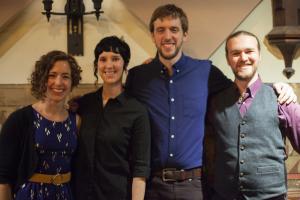 “Gather round, folks. Pull up a chair. Grab a drink. Make yourself comfortable... while you still can. There’s a maniac loose in society, and he’s here to tell you some stories,” so promises the back cover of MATT SPENCER’s new book, Story Time with Crazy Uncle Matt (Back Roads Carnival Books, 2018). According to his bio, Matt has been a “journalist, New Orleans restaurant cook, factory worker, radio DJ, and a no-good ramblin’ bum. He’s also a song lyricist, playwright, actor, and martial artist. As of this writing, he lives in Brattleboro, Vermont.”
“Gather round, folks. Pull up a chair. Grab a drink. Make yourself comfortable... while you still can. There’s a maniac loose in society, and he’s here to tell you some stories,” so promises the back cover of MATT SPENCER’s new book, Story Time with Crazy Uncle Matt (Back Roads Carnival Books, 2018). According to his bio, Matt has been a “journalist, New Orleans restaurant cook, factory worker, radio DJ, and a no-good ramblin’ bum. He’s also a song lyricist, playwright, actor, and martial artist. As of this writing, he lives in Brattleboro, Vermont.”
’07
In November, WILLOW O’FERAL presented a screening and discussion of Break the Silence, her important documentary on women’s sexual and reproductive health in Vermont, in Ragle Hall. The film was followed by a panel discussion by women from the film. “New Day Films has just accepted Break the Silence for educational distribution, which means I will now be able to get the film out to a much wider audience, and the film will soon be available for use by colleges, universities, libraries, nonprofits and high schools all across the country,” says Willow. Learn more at breakthesilencedoc.com.
’09
“I still work for a community mental health agency,” says TALIA JACKSON. “In the last year I started using EMDR to treat trauma, and I’m in a slow crawl to become a licensed clinical social worker. I am still in touch with classmates from Marlboro and consider them my best friends.”
Evan Lorenzen ’13: Creation Continued… 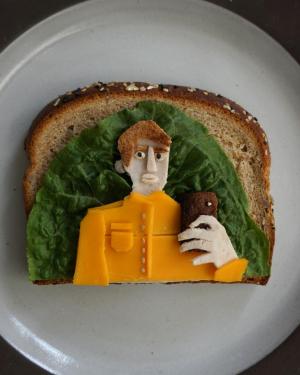 When Evan Lorenzen graduated from Marlboro with a Plan in visual arts, the sky seemed to be the limit for his creative endeavors. Appropriately, he is now living in the “mile-high city” of Denver, pursuing many forms of art—from large paintings to graphic design, animation to wine labels— and making a living at it.
When Evan Lorenzen graduated from Marlboro with a Plan in visual arts, the sky seemed to be the limit for his creative endeavors. Appropriately, he is now living in the “mile-high city” of Denver, pursuing many forms of art—from large paintings to graphic design, animation to wine labels— and making a living at it.
“I would not be in my current circumstances without the skill sets that I acquired at Marlboro,” says Evan, who created the animated videos for Marlboro’s Beautiful Minds Challenge for the last five years. “Marlboro and its ingenious professors, staff, and students provided me with not only innumerable techniques but also the critical-thinking and problem-solving skills required to push myself and my work to further and further levels.”
Soon after moving to Denver, Evan began working in miniature, making “tiny books” and other miniature paintings and illustrations without the use of magnifying instruments, such as a recent detail of Edward Hopper’s Nighthawks painted on a spoon. His unique skills are well adapted to tattoo art, which he provides at All Sacred Tattoo Studio, a group enterprise with a strong community-engagement focus.
“Besides being in an environment that promotes creativity and altruism, I really love tattooing because I interact with a wide range of fascinating individuals while practicing a craft that I am passionate about. I really enjoy being, in a way, a visual translator for my clients by helping them modify their bodies with imagery that is very personal and significant to them.”
’10
“These images interrogate how surveillance technology has changed our relationship to—and understanding of—landscape and place in the current geopolitical climate,” says MARCUS DESIENO in his artist’s statement for the Review Santa Fe Photo Festival, where he presented his show No Man’s Land: Views from a Surveillance State. “The resulting visual product becomes located from its automated origins and leads to an investigation of land, of borders, and power.” Marcus’s work earned him CENTER director’s choice second place award, but more importantly the admiration of VAUNE TRACHTMAN ’89 and BRIAN MOONEY ’90, who attended the festival and were thrilled to meet him.
Congratulations to GENAM YESHI, who published a Tibetan translation of Plato’s Phaedo. Philosophy professor William Edelglass visited Genam while at a conference in Dharamsala, India, last year.
’14
DAVID AMATO published a spy novel under the pseudonym Donatella Amarna, called Le Tigre Russe. Learn more.
MICHAEL SCHNEEWEIS, of Michael Jordan Touchdown Pass, was one of five Marlboro alumni and students featured in an indie music playlist of Brattleboro musicians past and present on BTRtoday's Spotlight on the City. Also included were ASA SHADIS ’19 and ALEX LAWSURE ’19 of A Million Yellow Flowers, AMBER SCHAEFER ’10 of Starfawn, and BELLA ORTIZ-WREN ’18, rounding out Marlboro’s solid representation on this playlist. Hear them.
’17
JOHN MCGILL and math professor Matt Ollis have co-authored a paper titled “On the asymptotic growth of bipartite graceful permutations,” in the research journal Discrete Mathematics. “The purpose of this paper was to explore the number of ways one can make graceful permutations as the size of the list increases,” said John. The paper grew out of research John had done with Matt while a Marlboro student, and was the basis of one of his Plan papers. Learn more.
’18
CHRIS LAMB gave a paper based on his Plan at the annual meeting of the International Association of Environmental Philosophy, and came home with the prize for best graduate student essay. “It was a validation of the work I have put in at Marlboro, the guidance I received there, and the overall preparation for continued work in academia. It was encouraging, considering my desire to continue on to graduate school.” Learn more.
Alex Fischer MBA ’14: Dismantling Capitalism 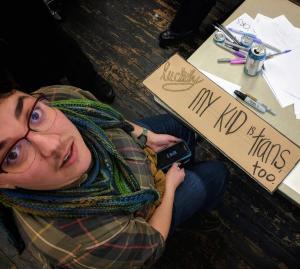 “Most of us don’t want to think about our relationship to money, because we are taught and raised to believe that capitalism is the air we breathe,” says Alex Fischer, founder of Open Bookkeeping and co-founder of The Root Social Justice Center, both in Brattleboro, Vermont. “I got into bookkeeping because I wanted to help support economies that are alternatives to capitalism.”
“Most of us don’t want to think about our relationship to money, because we are taught and raised to believe that capitalism is the air we breathe,” says Alex Fischer, founder of Open Bookkeeping and co-founder of The Root Social Justice Center, both in Brattleboro, Vermont. “I got into bookkeeping because I wanted to help support economies that are alternatives to capitalism.”
When Alex moved to Vermont from California and started Open Bookkeeping, they quickly realized that they wanted to use finance to work with businesses and alternative economies based on justice-oriented values and principles. For Alex, getting their MBA was about helping justice-based businesses, co-ops, nonprofits, and individuals thrive.
“My Marlboro MBA really gave me time to figure out this bizarre place I live and work in: the intersection of finance and social justice,” says Alex. “Spending two and a half years learning about and challenging notions of success and traditional business metrics allowed me to better understand my foundational values and perspectives.”
Alex helped co-found The Root in 2013, with the goal to create a co-working space for justice-based businesses and community organizing. As of 2017 The Root focuses on racial justice organizing in Vermont and the region led by people of color, and Alex has continued to fundraise and maintain finances for the organization as a way to support people-of-color leadership.
“Justice-based economies are made up of an ecosystem of organizations, businesses, co-ops, individuals—we need them to be resilient, successful and values-based, but we also need them to keep their doors open and pay their employees, worker-owners, contractors, and other parties.”
Management
In November, SUZANNE BANSLEY MBA’11 facilitated a workshop on “Listening Effectively” at the former Marlboro College Graduate Center. Suzanne covered nine listening pitfalls and nine listening techniques in this interactive workshop, part of a Toastmasters International series.
“A lot of what we talk about is what AmeriCorps members do for the community, and one of the things we don’t talk about as much is what AmeriCorps does for the person who is serving,” says PHILIP KOLLING MSM’14, executive director of SerVermont. He was quoted in a Bernie Sanders video announcing the allocation of $3 million in federal funds for AmeriCorps. Learn more.
“The working landscape and small farms in Vermont are still the best incubator for having people live in Vermont and be in Vermont and make business in Vermont,” said EMMET DUNBAR MSM’14 in the Fall 2018 issue of SoVermont Arts and Living. In an article titled “Farming Couples, Doing Less…Achieving More,” Emmett and his wife, Lini, describe how they transformed their South Londonderry farm into a more streamlined and profitable enterprise. “Lini and I have not just worked to develop our farm’s products for ourselves, we have been instrumental in creating the alternative food and local agricultural economy in Vermont,” he added. Learn more.
“I have been impressed for many years by the Amherst Survival Center’s commitment to leverage volunteers, donations, and advocacy to create inclusive community, starting by meeting people’s most basic needs,” said K. LEV BEN-EZRA MSM’17. In December, Lev was appointed as the new executive director of the center, which provides support for low-income residents throughout the Amherst, Massachusetts, region. Learn more.
AMANDA MEHEGAN MBA’18 has been selected to participate in the 2018-2019 Vermont Changemakers Table organized by Vermont Businesses for Social Responsibility and the High Meadows Fund. Part of a cohort of 25 young Vermonters committed to positive change, Amanda will meet with her group quarterly for dinner, conversation, and inspiration from Vermont thought leaders. A second Marlboro MBA alum, ALEX FISCHER MBA’14, was also selected for this honor.
Teaching
JASMIN BEY COWIN MAT’17 writes, “I am now a full-time assistant professor responsible for course migration from Blackboard to Canvas in the TESOL department at Touro College. In October, I will start my fellowship at Columbia University in Educational Leadership and Policy with an eye on moving out of Westchester in 2021. I am hoping to find something in Massachusetts, New Hampshire, or Vermont, however, everything and anything is possible, including international. Marlboro was a great experience.”
Former Faculty
Responding to the Tree of Life synagogue shooting in October, former president TOM RAGLE said in a letter to the editor of the Brattleboro Reformer, “This was more than an act of anti-Semitism. It was a crime against humanity. I am human. It was a crime against my brothers and sisters, against me. Only when we are able to see a crime such as this not as a crime against Jews or Muslims or Blacks or Native Americans but a crime against humanity, against us, against me, will we realize the peace we so desperately and unsuccessfully seek.”
Faculty Emerita LAURA STEVENSON’s latest project is reviewing all new fiction and nonfiction written by Vermont authors, starting with 2018. “The reviews appear in the Deerfield Valley News, but they also appear on the opening page of my website: lauracstevenson.org,” she says. “The idea, besides giving Vermont authors credit that many of them don’t get because they publish with small presses, is to give readers a bibliography of what local writers are writing.”
In September, retiring visual arts faculty members Cathy Osman and Tim Segar presented three concurrent exhibits, two at the college—in the Snyder and Drury Galleries—and one in downtown Brattleboro at the Catherine Dianich Gallery. The shows included painting, prints, and sculpture taken from several parts of their career, including new work.
“Greetings from Guatemala,” writes CAROL HENDRICKSON, anthropology faculty emerita. She was there as a volunteer with the Maya Educational Foundation English language program, working with Maya university students who want to improve their English language proficiency. “I did the TESOL certificate program with Bev Burkett . . . thank you, Marlboro College, for that opportunity.” Then Carol went to Tecpán Guatemala, where she has research for many years. “I’m here visiting friends and also preparing to write about my experiences over the past (nearly) 40 years (Yipes!). The plan is that I and another anthropologist who has worked in Tecpán will have this book manuscript translated and published in Spanish.”
In Memoriam
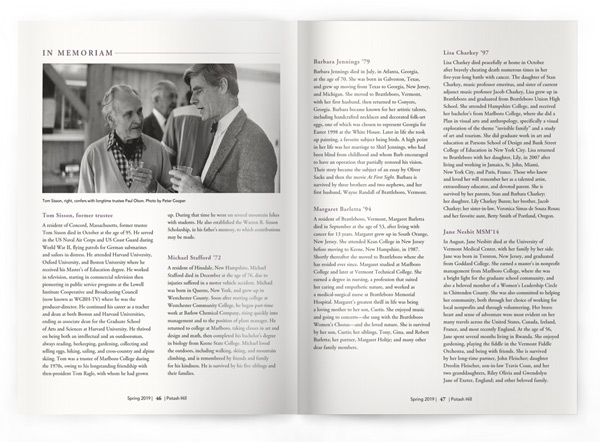
Tom Sisson, former trustee
A resident of Concord, Massachusetts, former trustee Tom Sisson died in October at the age of 95. He served in the US Naval Air Corps and US Coast Guard during World War II, flying patrols for German submarines and sailors in distress. He attended Harvard University, Oxford University, and Boston University where he received his Master’s of Education degree. He worked in television, starting in commercial television then pioneering in public service programs at the Lowell Institute Cooperative and Broadcasting Council (now known as WGBH-TV) where he was the producer-director. He continued his career as a teacher and dean at both Boston and Harvard Universities, ending as associate dean for the Graduate School of Arts and Sciences at Harvard University. He thrived on being both an intellectual and an outdoorsman, always reading, beekeeping, gardening, collecting and selling eggs, hiking, sailing, and cross-country and alpine skiing. Tom (pictured above with longtime trustee Paul Olson), was a trustee of Marlboro College during the 1970s, owing to his longstanding friendship with then-president Tom Ragle, with whom he had grown up. During that time he went on several mountain hikes with students. He also established the Warren R. Sisson Scholarship, in his father’s memory, to which contributions may be made.
Michael Stafford ’72
A resident of Hinsdale, New Hampshire, Michael Stafford died in December at the age of 76, due to injuries suffered in a motor vehicle accident. Michael was born in Queens, New York, and grew up in Westchester County. Soon after starting college at Westchester Community College, he began part-time work at Barlow Chemical Company, rising quickly into management and to the position of plant manager. He returned to college at Marlboro, taking classes in art and design and math, then completed his bachelor’s degree in biology from Keene State College. Michael loved the outdoors, including walking, skiing, and mountain climbing, and is remembered by friends and family for his kindness. He is survived by his five siblings and their families.
Barbara Jennings ’79
Barbara Jennings died in July, in Atlanta, Georgia, at the age of 70. She was born in Galveston, Texas, and grew up moving from Texas to Georgia, New Jersey, and Michigan. She moved to Brattleboro, Vermont, with her first husband, then returned to Conyers, Georgia. Barbara became known for her artistic talents, including handcrafted necklaces and decorated folk-art eggs, one of which was chosen to represent Georgia for Easter 1998 at the White House. Later in life she took up painting, a favorite subject being birds. A high point in her life was her marriage to Shirl Jennings, who had been blind from childhood and whom Barb encouraged to have an operation that partially restored his vision. Their story became the subject of an essay by Oliver Sacks and then the movie At First Sight. Barbara is survived by three brothers and two nephews, and her first husband, Wayne Randall of Brattleboro, Vermont.
Margaret Barletta ’94
A resident of Brattleboro, Vermont, Margaret Barletta died in September at the age of 53, after living with cancer for 13 years. Margaret grew up in South Orange, New Jersey. She attended Kean College in New Jersey before moving to Keene, New Hampshire, in 1987. Shortly thereafter she moved to Brattleboro where she has resided ever since. Margaret studied at Marlboro College and later at Vermont Technical College. She earned a degree in nursing, a profession that suited her caring and empathetic nature, and worked as a medical-surgical nurse at Brattleboro Memorial Hospital. Margaret’s greatest thrill in life was being a loving mother to her son, Curtis. She enjoyed music and going to concerts—she sang with the Brattleboro Women’s Chorus—and she loved nature. She is survived by her son, Curtis; her siblings, Tony, Gina, and Robert Barletta; her partner, Margaret Holtje; and many other dear family members.
Lisa Charkey ’97
Lisa Charkey died peacefully at home in October after bravely cheating death numerous times in her five-year-long battle with cancer. The daughter of Stan Charkey, music professor emeritus, and sister of current adjunct music professor Jacob Charkey, Lisa grew up in Brattleboro and graduated from Brattleboro Union High School. She attended Hampshire College, and received her bachelor’s from Marlboro College, where she did a Plan in visual arts and anthropology, specifically a visual exploration of the theme “invisible family” and a study of art and tourism. She did graduate work in art and education at Parsons School of Design and Bank Street College of Education in New York City. Lisa returned to Brattleboro with her daughter, Lily, in 2007 after living and working in Jamaica, St. John, Miami, New York City, and Paris, France. Those who knew and loved her will remember her as a talented artist, extraordinary educator, and devoted parent. She is survived by her parents, Stan and Barbara Charkey; her daughter, Lily Charkey Buren; her brother, Jacob Charkey; her sister-in-law, Veronica Simas de Souza Rosas; and her favorite aunt, Betty Smith of Portland, Oregon.
Jane Nesbit MSM’14
In August, Jane Nesbitt died at the University of Vermont Medical Center, with her family by her side. Jane was born in Trenton, New Jersey, and graduated from Goddard College. She earned a master’s in nonprofit management from Marlboro College, where she was a bright light for the graduate school community, and also a beloved member of a Women’s Leadership Circle in Chittenden County. She was also committed to helping her community, both through her choice of working for local nonprofits and through volunteering. Her brave heart and sense of adventure were most evident on her many travels across the United States, Canada, Ireland, France, and most recently England. At the age of 56, Jane spent several months living in Rwanda. She enjoyed gardening, playing the fiddle in the Vermont Fiddle Orchestra, and being with friends. She is survived by her long-time partner, John Fleischer; daughter Dreolin Fleischer, son-in-law Travis Coan, and her two granddaughters, Riley Olivia and Gwendolyn Jane of Exeter, England; and other beloved family.
Magnanimity Cum Laude
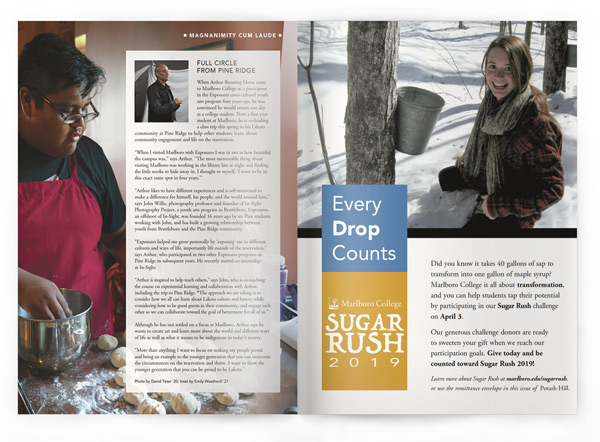
Full Circle from Pine Ridge
 When Arthur Running Horse came to Marlboro College as a participant in the Exposures cross-cultural youth arts program four years ago, he was convinced he would return one day as a college student. Now a first-year student at Marlboro, he is co-leading a class trip this spring to his Lakota community at Pine Ridge to help other students learn about community engagement and life on the reservation.
When Arthur Running Horse came to Marlboro College as a participant in the Exposures cross-cultural youth arts program four years ago, he was convinced he would return one day as a college student. Now a first-year student at Marlboro, he is co-leading a class trip this spring to his Lakota community at Pine Ridge to help other students learn about community engagement and life on the reservation.
“When I visited Marlboro with Exposures I was in awe at how beautiful the campus was,” says Arthur. “The most memorable thing about visiting Marlboro was working in the library late at night and finding the little nooks to hide away in. I thought to myself, ‘I want to be in this exact same spot in four years.’”
“Arthur likes to have different experiences and is self-motivated to make a difference for himself, his people, and the world around him,” says John Willis, photography professor and founder of In-Sight Photography Project, a youth arts program in Brattleboro. Exposures, an offshoot of In-Sight, was founded 16 years ago by six Plan students working with John, and has built a growing relationship between youth from Brattleboro and the Pine Ridge community.
“Exposures helped me grow personally by ‘exposing’ me to different cultures and ways of life, importantly life outside of the reservation,” says Arthur, who participated in two other Exposures programs at Pine Ridge in subsequent years. He recently started an internship at In-Sight.
“Arthur is inspired to help teach others,” says John, who is co-teaching the course on experiential learning and collaboration with Arthur, including the trip to Pine Ridge. “The approach we are taking is to consider how we all can learn about Lakota culture and history while considering how to be good guests in their community, and engage each other so we can collaborate toward the goal of betterment for all of us.”
Although he has not settled on a focus at Marlboro, Arthur says he wants to create art and learn more about the world and different ways of life as well as what it means to be indigenous in today’s society.
“More than anything I want to focus on making my people proud and being an example to the younger generation that you can overcome the circumstances on the reservation and thrive. I want to show the younger generation that you can be proud to be Lakota.”
Photo by David Teter ’20; Inset by Emily Weatherill ’21
Sugar Rush 2019
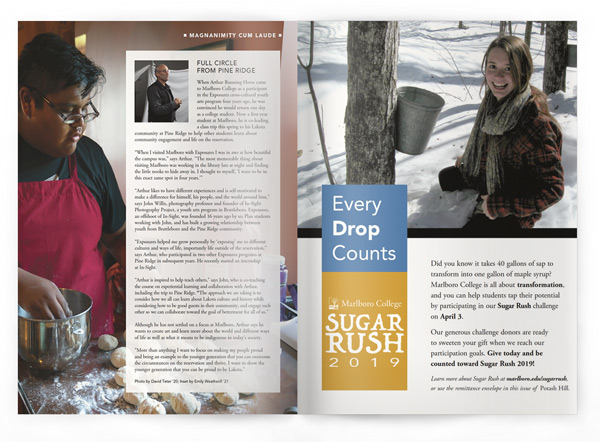
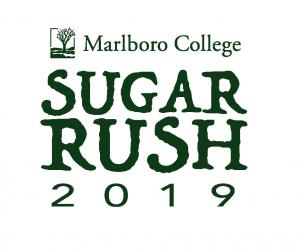 Every Drop Counts
Every Drop Counts
Did you know it takes 40 gallons of sap to transform into one gallon of maple syrup? Marlboro College is all about transformation, and you can help students tap their potential by participating in our Sugar Rush challenge on April 3.
Our generous challenge donors are ready to sweeten your gift when we reach our participation goals. Give today and be counted toward Sugar Rush 2019!
Learn more about Sugar Rush at marlboro.edu/sugarrush.
Special Web Features
America in the Ahistorical Age: An interview with Kate Ratcliff
In December, Danielle Scobey ’22 sat down with American studies professor Kate Ratcliff to talk about oral history, aging, and radical decontextualization in America.
Danielle: How long have you been teaching here, Kate?
Kate: Well, I have been at Marlboro College for 30 years. I think it's 30 because I came in 1989.
D: How would you describe what you teach here?
K: My field is American studies, which is the interdisciplinary study of U.S. history and culture. In general, my courses explore the connections between socio-historical forces and forms of cultural expression. Marlboro has been a wonderful place to do the kind of broad, integrative work that defines American studies. I feel incredibly lucky to have landed here 30 years ago, and it's been an amazingly rich place to teach and grow as an academic. I was so excited when I saw the Marlboro job posting because it invited applications from people who wanted to teach a wide range of courses. That was so different from the other job descriptions, which designated something specific like the Gilded Age or 19th-century women's history. So I saw the Marlboro job and I literally got a shiver down my spine because the fit felt so right.
D: What’s the best part about teaching at Marlboro?
K: Because our jobs are fairly broadly defined, we have space to develop new interests, which is such a luxury and I think it contributes a lot of vitality to the institution. There really is the sense that that students and faculty are continuously learning together and alongside one another.
Over the course of 30 years I've been basically tasked with covering a whole field—although we don't talk about coverage in that sense because it’s not realistic to imagine a single person covering a field. At the same time, most of most of us do feel responsible for offering a range of courses that address key aspects of our disciplines. Over the years I've taught courses on political, environmental, social and cultural history. I regularly teach a course on the history of the family and one on the history of political life. For the past two elections I've taught a course called Voting and Elections in US History, which looks at elections and voting historically and relates those patterns to the context of the current Presidential election.
Another great thing about Marlboro is the opportunity for team teaching. I’ve had the incredible privilege of teaching with so many colleagues over the years. Jenny Ramstetter and I teach a course called the History and Ecology of the Western United States. We've framed it differently under that topic heading, but the past couple times we focused on wilderness. We're going to teach that course again in the spring, which I'm excited about because we haven't taught it in a few years. I've also done team teaching with John Willis—a course in documentary photography. And I’ve collaborated with Felicity Ratté on public art, and with Carol Hendrickson on Cuba.
K: Gosh, this semester all I did was team teaching. I team taught three courses. I don't think I would do that many at one time again because actually it's tricky to team teach. It's rich, you know, I love it. It's so stimulating. But there's this whole additional layer of coordination. This semester I'm teaching with Kristen Horrigan the Community Governance Colloquium, which is I think maybe the third iteration of that course. This is one of those new interests that Marlboro has allowed me to develop: community engagement. It’s such a rich moment to be dipping into that world. For a lot of years—I'm thinking back to when I was an undergraduate— college students have been doing volunteer work, but something different has happened in the past five to ten years. Colleges and universities are looking in a deeper way at the theory and practice of community engagement and it has become a very rich and interesting intellectual subject in its own right.
D: What else did you team teach this semester?
K: I taught a new course with Kate Tzraskos, the director of experiential learning and career development. The class was awesome—the idea was to create a credit-bearing space with academic content from which students could do work in the wider community. We partnered with Groundworks Collaborative, which is a direct service organization that has two shelters and a food shelf and provides a lot of support services for people in need in Brattleboro. So students did about three to four hours of volunteer work a week with Groundworks. Partnering with just one organization gave us some common content to work with.
D: And what did you do on the academic side?
K: We studied issues of homelessness and poverty. We read Matthew Desmond's book Evicted: Poverty and Profit in the American City, It’s a powerful book that blends individual life stories with compelling analysis of the structural forces that produce and perpetuate inequality. The class also looked at cultural ideas about poverty and we talked about the myth of meritocracy. They did a lot of thinking about their own social location, because it's a basic principle that if you're going to work in the community you also need to be reflective about where you are coming from. In all, it was really a powerful experience, and the students were so great. They were so thoughtful and so self reflective and open and engaged.
D: So what are you going to be teaching next semester?
K: I'm teaching the Culture and Ecology of the US West, with Jenny. We taught that class for the first time in the early 90s. I’ve continued to learn so much every time we teach it. It can be challenging to blend really different disciplines and perspectives in a single course and students (and faculty) invariably find themselves having to stretch a lot to engage the field that is not their academic home. It’s powerful and important to think about the health of ecological systems and human communities in a holistic way.
I will also be teaching Consumer Culture in Historical Perspective. Consumer culture, is in many ways, the air we breathe and the course is designed to explore the historical roots and development of a culture and economy organized around mass production and mass consumption.
D: Do you have other recent interests you are pursuing in classes?
K: One relatively recent area of interest is oral history. That's just been so broadening for me. I love archival material and there's nothing like dusty documents to make my heart go pitter patter, yet I actually find it much more enjoyable to talk to people.
I’m trained as a historian and my previous research has been primarily archival. Oral history encompasses the lived experiences of people reflecting on the past and allows voices not previously part of the historical record to be included. It opens up so much.
D: How did you get interested in oral history?
K: Another great thing about Marlboro is how the college will support you in learning new things. In 2016 I went to Oral History Summer School, which is a three-week intensive program.
In Hudson, NY. I also did another training in Middlebury. Shortly after that I team taught a course with HB Lozito, who heads up the Green Mountain Crossroads project in Brattleboro, an organization focusing on rural LGBTQ people, and Ain Gordon, an historically oriented performance artist from New York. We collaborated to create a class focusing on radical movements in Southern Vermont in the 1970s.. All the students did projects based on oral history interviews with people who had been involved in local countercultural activities in the late 60s and 70s. Oral history has become an important part of my teaching in the past few years.
D: You’ve used it in other courses?
K: Yes. Oral history is an essential part of a new course I developed called Growing Old in America. I’ve taught it a couple of times and will teach it again in the near future. The origins of the course were personal. My father died recently from Alzheimer’s disease, and my mother also has Alzheimer's. I spent a lot of time in the past few years caring for them and thinking a lot about aging. I did what academics generally do when they confront a new topic—I researched and read—and I discovered that there's this rich interdisciplinary field called aging studies. It cuts across the humanities and social sciences and biological sciences. I started thinking about how exciting it would be to create a new course.
D: So you did a course about aging?
K: It was my first real community engagement course. One of the reasons I had hesitated in the past about incorporating community engagement in my courses is that I wanted it to be organically tied to the content of the class. The Aging course was a natural fit for community engagement. All the students worked with institutions in Brattleboro that serve an older population. And they all did oral history/life review with someone they met. We were able to make deep connections between the academic material and their work in the community.
D: So with all your interest in interdisciplinary studies, do you have any big projects on the horizon?
K: I want to do some kind of oral history based project that focuses on aging. Since I developed the course I have been invited to give several lectures on aging and I have made a lot of contacts I can draw upon in designing a project. There is interesting recent scholarship that looks at the struggles of older women around issues of appearance and the body and what it means to age in a culture that puts such a premium on youth and a particular kind of beauty. I’d like to explore that. I would also like to pursue research on feminist organizing in the Brattleboro area in the early 70s. I discovered some new archival material when we taught the 70s class. Now is the time to gather oral histories from people who were politically active in the 70s. I did not mention it before in talking about my classes, but gender studies has been a major teaching area for me and a lot of my own research interests come out of that.
D: Do you have any Plan students at the moment?
I'm working with Zoey DeHart. Her fields are history and politics, and her focus is prison studies. In our tutorials she has been doing research on the history of Angola prison. Zoe received Town Meeting money and went to Angola over Hendricks Days to see the prison, and to observe an annual event at the prison called Rodeo, where the prisoners put on a rodeo for spectators. I’m also working with Day Rodriquez who is pursuing a Plan focusing on issues relating to Design and Environmental Psychology, and with Elizabeth Johnson who is just starting Plan work that focuses on public libraries.
D: With the new professors coming to Marlboro do you think you're going to do any projects with them, maybe teach a class together?
K: For sure! I can imagine teaching classes with many of them. We have an extraordinary group of recent hires. Marlboro attracts faculty members who have wide-ranging interests so it seems likely that I would be collaborating with some of my new colleagues in the future.
D: Why is it important to learn about history?
K: So much of history is about learning to see the world through the eyes of other people. That's what oral history brings to the table. That's what community engagement allows, and that's definitely what history fosters. I feel like the study of history is critical at this moment. We live in a culture that is ahistorical, and arguably hostile to history. There's virtually no reference to historical context in any kind of media analysis. I take that back, because Presidential historian Michael Beschloss does get trotted out to say some wise words on public TV. He's the main one—Doris Kearns Goodwin too, every now and then. It relates to the orientation of a consumer-based culture. We live in a world that's so decontextualized, and that's really the heart of “consumer culture.” Consumer items are goods without origin. You don't see the context. In fact, maintaining the whole spectacle of consumer culture requires us to ignore that context. You don't want to think about where a product comes from, or what kind of labor went into creating it, or who made it under, what conditions, and what resources were consumed. All of that obfuscation creates the the magic of consumption. In a consumer-oriented society we don’t practice thinking critically and contextually. Historical thinking is an antidote of sorts. Studying history helps cultivate empathy, nuance, complexity, and an appreciation for both continuity and change.
D: In 30 years how has Marlboro changed?
K: Ah, that's a great question. I would say there is both change and continuity. Certainly there's continuity in terms of the kinds of students who are drawn to Marlboro, who are passionate and creative who have ideas they want to pursue. I'd like to do some more empirical data on this, but one theme that I've heard so often is about an ambivalent relationship to high school and a critical approach to traditional education.
D: And is there change?
K: In recent years I feel there can be a kind of orthodoxy about particular political opinions and perspectives—what I would describe as a kind of rush to judgment. I feel like there's more of that now. Kind of a sense of—dare I say— political correctness. I hate to use that terminology because I think it's been so misused. Yet I do have a sense of a community that can sometimes be intolerant in the name of tolerance! Students in the Community Governance Colloquium identified that as the issue they wanted to address in our class project. You may have seen some of the posters they created that are all over the campus with the tag line: “Can we agree to disagree”?
D: Yes, I enjoyed those.
K: We spent a lot of time in the seminar talking about issues relating to civic discourse. Students shared that it can be hard to hold an opinion in this community that runs counter to dominant opinion. Talking across difference is still the ideal but not always robust in practice. I certainly don't blame students because it's not just happening on college campuses, it's the whole culture. We live in a time of such polarization, and I think that that problem manifests in multiple places in society. That ability to talk across differences is so important, and I think that's a skill that Marlboro College is uniquely positioned to help foster.
D: In your web profile you said: “History is not simply a matter of learning what happened in the past, it is a process of selecting, ordering, and interpreting past events and experiences. I want students to see that they have a stake in that process. The stories we tell about the past shape the way we perceive the present and envision the future.”
K: There I'm pushing against the idea that history is just facts, that it's inherently objective. History is a story, and it's always constructed from a particular view. It always highlights some things and obscures others. And at the same time history is a professional practice that seeks to get as close as possible to what might be considered a truthful version of events. I think it's interesting how recent politics have shifted the discussion about the nature of truth.
D: Alternate facts?
K: Yes, a lot of historians who 20 years ago were arguing vociferously for the constructed nature of everything, are now framing those arguments differently in the context of our dystopian political moment.